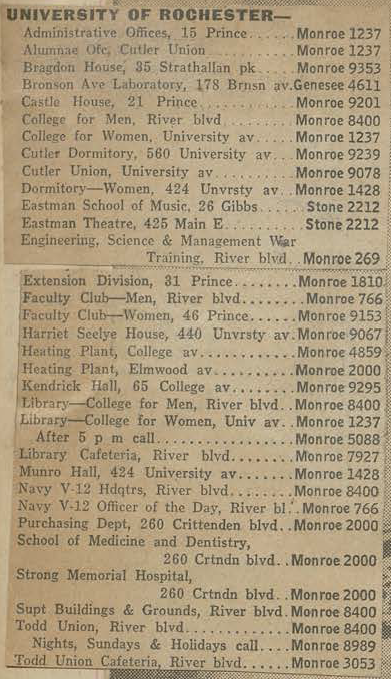
| Campus Technology |
 |
| Rochester Past and Present: An animated scrap book for the edification of future local historians, by William Wilkinson, Page 62 (June 1947) |
|
Telephones | Computers
| Networks | Personal
Technology | Classroom Technology | Fire and Security | Locks | References |
The University of Rochester has used a variety of telephones, computers, and networks over its life. Some highlights of this history are noted here.
Telephones
The Rochester
Telephone Corporation was founded in 1920 as a merger of Rochester
Telephonic Exchange and Rochester Telephone Company. Rochester was
the largest city in the country with a non-Bell telephone system.
In 1929 the University had four internal exchanges, each with its own number, operators and switchboard. By 1967 the University had thirteen such exchanges and calls between these exchanges had to go through the respective operators. The University contracted with Rochester Telephone to install a new Centrex system manufactured by Stromberg-Carlson that would allow one prefix (275) to serve the entire University with individual extension numbers for each telephone. The new system also allowed direct inward dialing and was installed at 1510 Mt. Hope.
The Centrex system was a great improvement, but the deregulation of the telephone industry in 1984 opened up a range of new options. The University selected a Rolm telephone system in 1986 and added a second prefix (274), which required a transition to five-digit internal phone numbers. RolmPhone sets were offered in a variety of sizes, ranging from the simple 120 to the 400 and could be equipped with a Data Communications Module allowing a computer serial connection at speeds up to 19,200 baud.
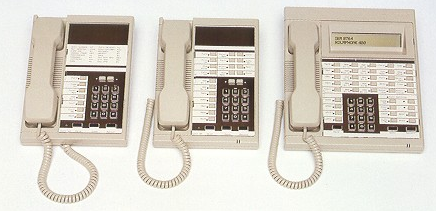 |
| RolmPhones |
The Rolm system was maintenance intensive and not Y2K compliant, so it was replaced with a NEC telephone system in 1999. More recently the University has moved to Voice-over-internet (VOIP) telephones.
The Fall 1991 issue of Rochester Review includes the earliest reference to a University fax machine used for RLIN inquiries, and the 1992-93 Undergraduate Bulletin includes two fax numbers related to admissions.
Wired telephones were removed from dormitory rooms in 2009, but students can request installation of a digital telephone with voice mail at a current annual cost of $175. It is unknown how many students contract for this service.
Computers
After five years of study, a computing center was established in Taylor
Hall in January 1956. The first computer installed was a Burroughs
E101, which weighed 1800 pounds, consumed 3000 watts and was accepted on
April 1, 1956..
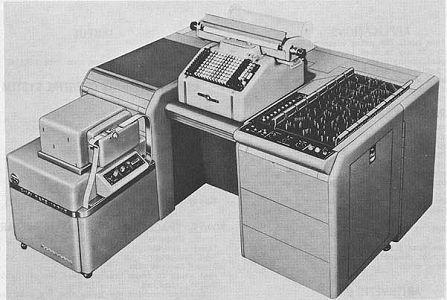 |
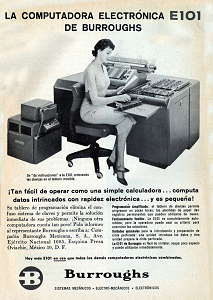 |
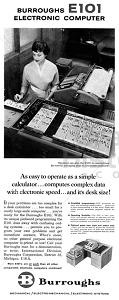 |
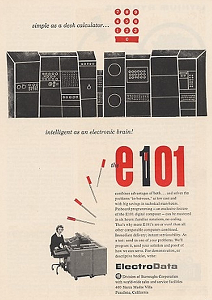 |
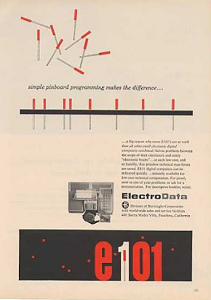 |
| Burroughs E101 | ||||
An IBM 650 was installed that summer and was accepted on July 10, 1956. This was the first mass produced computer in the world and the most popular computer of the 1950s, with almost 2,000 systems produced between 1954 and 1962. The IBM 650 Tape unit required 42 KVA, weighed 15,000 lbs. and required 9 Tons of refrigeration.
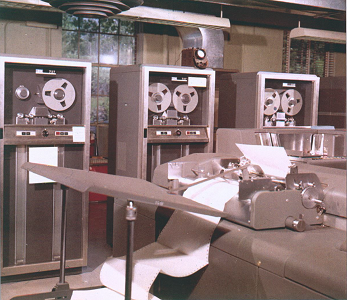 |
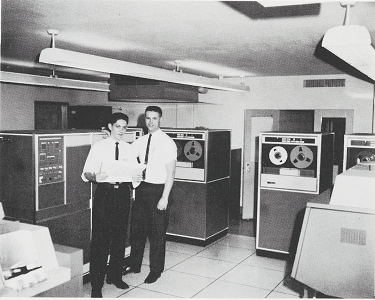 |
| IBM 650 with tape drives in Taylor Hall | IBM 1401 |
A Burroughs E102 was added in March 1958 and the IBM 650 was replaced by an IBM 7070 in 1961. An IBM 1401 interface unit was added to increase throughput and the 7070 was upgraded to a 7074 in April 1962. An IBM 620 was installed in Hopeman in August 1962 for student use and was moved to Taylor Hall after the IBM 7074 machine was moved to the Towne House.
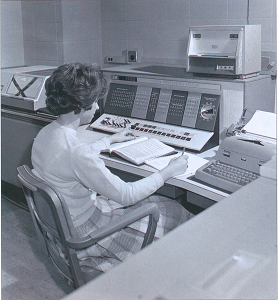 |
| IBM 1620 |
A larger data center was installed in the ground floor of the Towne House Motor Inn expansion in the summer of 1966.
An IBM 360 Model 50 and an IBM 1130 were installed in 1967, the latter perhaps replacing the older IBM 1620. The Model 50 was replaced by an IBM 360 Model 65 that began operation on September 11, 1968. The Model 50 was then moved to the basement of the Administration building where it replaced an older IBM 1401 used for administrative data processing including Registrar, Academic, and Business offices. The IBM 360 Model 65 was in replaced by an IBM 3032 in July 1978, and the administration data processing functions were then transferred to this new machine.
In the early 1980s a DECsystem-2060 and VAX 11/780 mega-mini were installed in Taylor.
Xerox donated four Alto computers to the University in 1974, which were named John, Paul, George and Ringo. The Xerox 8100 was introduced in 1981 and with the Xerox Star software package was the first commercial system to incorporate a bitmapped display, a windows-based graphical user interface, icons, folders, mouse, Ethernet networking, file servers, printer servers and e-mail. The system had 384 KB of memory expandable to 1.5 MB, an 8" floppy drive, and a 10, 29, or 40 MB hard drive. The Medical Center bought a cluster of them to support production of grant proposals. Xerox awarded the university a grant in 1984 to buy 12 Xerox Star workstations connected by an Ethernet network.
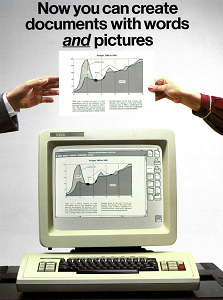 |
| 1981 advertisement for Xerox 8010 Information System. |
IBM Magnetic Tape Selectric typewriters were introduced in 1961, but.the first serious initiative towards word-processing on campus started in 1982, replacing electric typewriters. Systems from Wang, DEC, IBM, and Xerox were tested and the University reportedly bought 300 to 400 Xerox 860's (large cases) and 820's (desktop) with 8" floppy drives for use by individual departments. Both were CP/M based machines and the 820 used a modified version of WordStar. These were not well supported by Xerox and were displaced within a few years by Macintosh computers and a wide variety of machines derived from the original IBM PC. Early personal computers loaded programs using a cassette tape, but floppy disks soon became prevalent, initially 8 inches, then 5¼ and finally 3½ inches, evolving from single-sided, single-density to double-sided, double-density. Compact discs came into use for software programs and storage, but flash drives ended the reign of floppy disks. Other storage technologies such as the Iomega Zip Drive also appeared for short periods. Early programs were not copy protected, and software piracy became a major issue, as would later audio and video piracy and file-sharing.
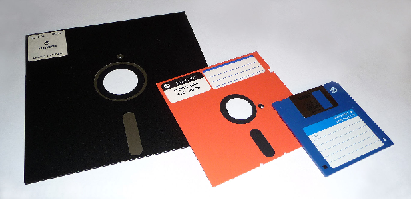 |
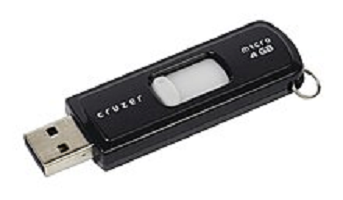 |
| 8, 5¼ and 3½-floppy disks | USB Flash Drive |
A Computer Interest Floor was proposed by students Matt Curtis and Peter Thompson in the fall of 1982, and began on the 11th floor of de Kiewiet tower in the fall of 1983.
The university received a
DARPA
grant of $750,000 in 1985 to purchase a BBN
Butterfly parallel computer built by Bolt, Beranek and Newman,
which was initially installed in the Towne House until the Computer
Science building was completed in 1987.
The Simon School of Business bought an HP-3000 in 1982 and an IBM 4300 in 1987, which may be been purchased with a grant from the IBM Management of Information Systems (MoIS) 1985-1990 Grant Program.
The University libraries installed a Geac 8000 electronic card catalog that began operating in 1985 and was named Chester, which was short for Rochester and also evoked Chester Dewey and Chester Carlson. The system was upgraded to a Geac 9000 in 1988, but was obsolete by 1995 and was replaced by the Voyager catalog in January 1997. This was replaced by Alma on July 30, 2019, and then upgraded to Primo on July 12, 2021, which is known as DiscoverUR.
The initial plan was to lease the computer center space in the Towne House for five years, but the University ended up buying the building in 1980 and kept it in use as a computer center until the planned demolition of the Towne House led to the 2007 purchase of a building at 300 Science Parky to house the primary data center. A backup data center was established in Farmington in 2013.
A former IBM data center on Long-Pond Road was purchased in 2023 and will be ready by 2025.
Networks
Initial data communication was done with telephone lines and internal
wiring between buildings.
The University was connected to the ARPANET by March 1974 through a port at the Rome Air Development Center.
The University started a campus-wide bulletin board in 1985, which morphed into a campus-wide information system known as CURIO.
The University connected to the NYSERNet in January 1987, which carried traffic at 56,000 bits of information per second. This network was updated to 1.5 million bits per second in the summer of 1988.
The Rolm telephone system offered telephone sets with an optional Data Communications Module that allowed a computer serial connection at speeds up to 19,200 baud. All student rooms were equipped with this option, and an additional data port was available so that more than one student in a room could connect. The Rom system allowed connections to resources such as Curio, CMS, Dbvax, Vera, Tut, etc.
Planning for a University-wide data network began in 1985 and in 1986 AT&T installed the first fiber optic cable. Ethernet ports were installed in departments and in 1996 and 1997 all dorm rooms had ethernet ports available for every student, allow them to surf the web and share music on Napster, along with other useful activities.
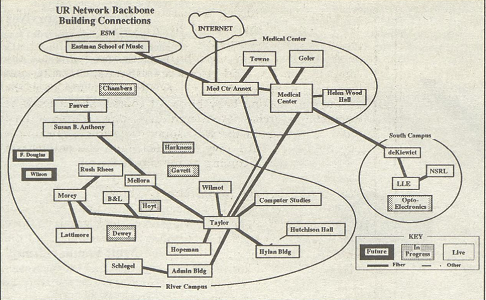 |
| University Network Map, from Campus Times, March 26, 1992, Page 4 |
The university received a National Science Foundation grant in 1999 to connect to Internet 2, a higher-speed research network with over 500 users. Installation of a campus-wide wireless network began in 2002.
Networks inside and outside of buildings have continued to expand to handle increased data traffic.
Of special interest is that 1942 UR PhD Joseph Carl Robnett Licklider is largely credited with the idea of networks and cloud storage.
Personal Technology
Commercial radio broadcasting began in Rochester when station WHQ began
operating on March 1, 1922 and quickly attracted the interest of George
Eastman, who invited the station to move to the new Eastman Theatre in
order to broadcast live programs. More powerful equipment was soon
installed and the station, backed jointly by the Times-Union, Democrat and
Chronicle, and University of Rochester, was ready for its first broadcast
on July 11, 1922.
Students had radios in their dorm rooms, but a five-dollar annual aerial fee was charged starting in 1939 to pay for building aerials since individual receivers did not work well inside the dorms. Students complained, and it was decided to allow phonographs in dorms, but they are also subject to the annual fee. It is not known how long this fee existed.
A 1940 Carnegie grant provided 950 records and a record player for Todd Union, and in 1959 a record room opened in Rush Rhees where students could listen to records through headphones while studying.
The campus radio station (WRUR) began operating on February 9, 1948, transmitting over the campus electric network, with a leased telephone line carrying the signal to the Women's College on Prince Street.
Battery-powered portable radios appeared in the late 1930s, but the introduction of the transistor radio in 1954 provided a unit that would fit into a larger pocket. Sony's 1979 Walkman opened up a new world of music opportunities, which were expanded with the 2001 introduction of the Apple iPod, whose features were carried over into the iPhone and other smart phones.
Classroom Technology
Chalkboards (commonly called blackboards but they can also be green) have
probably been a feature of campus classrooms since 1850, but there are few
references to them in the historical record. Whiteboards
became common in the 1990s, but never replaced their older chalk brethren.
Magic Lanterns, or optical lanterns, displayed lantern slides and were used in many classroom in the late 19th Century. Herman Leroy Fairchild, geology professor from 1888-1920, was the first professor at the University to use visual instruction in his classes using a lantern slide projector that he himself had built. He modified the light source as technology advanced. His papers are in the Rush Rhees Library Rare Books and Special Collections and include his projector.
| Geology
Professor Herman Leroy Fairchild's Lantern Projector Courtesy of Rare Books, Special Collections and Preservation. |
|||
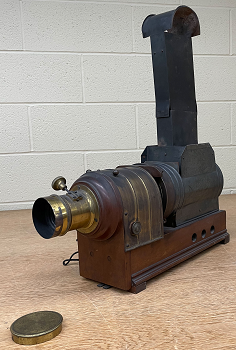 |
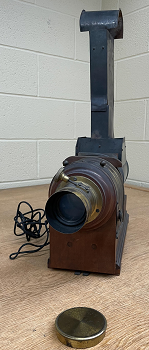 |
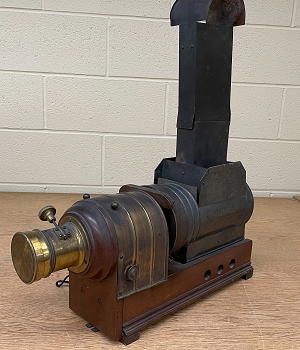 |
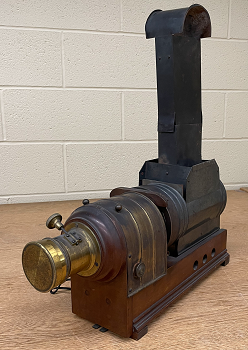 |
These machines were replaced by 35mm slide projectors in the 1950s, with later versions using larger carousel trays that could hold up to 100 slides. Although many early slides only included pictures and artwork, the introduction of presentation software programs in the late 1970s could be used to produce 35mm slides from a software file, including text. The most popular of these today is Powerpoint, which was introduced for the Macintosh in 1987 to make overhead transparencies. Microsoft bought the program three months after it came out and included it in its Office Suite, with later versions able to produce 35mm slides and videos.
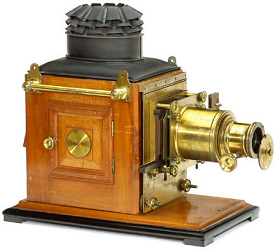 |
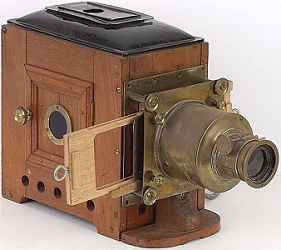 |
 |
 |
| Lantern Slide Projector | Single Slide Projector | Tray Slide Projector | Carousel Slide Projector |
LCD Projectors were introduced in the 1990s and later a variety of Video Projectors came on the market that could project both still and moving images from a computer. These projectors are installed in many classrooms and auditoriums on campus.
Overhead projectors came into use by the military during World War II, and were rapidly adopted in higher education after the war. A few are still used by some professors. Document cameras have also been installed in several classrooms to project images from a document onto a screen.
The first movie projector was installed at the Eastman Theatre in 1922 and had a 160-foot throw. George Eastman converted this projector to use sound in 1928. The student association bought a 16mm movie projector in early 1951 for use by student organizations, and projectors were also used to show films in classrooms. These too have been replaced by video projectors.
Human Resources
Management System (HRMS)
The University's HR operation used a variety of different programs, most
of which were not Y2K compliant. A new system was purchased from
PeopleSoft, which was initially balled Human Resources Information
System. This system went live on July 1, 1999.
The 1999 system is being replaced by a new HR system from Workday, which is currently being implemented.
Time Management System
A centralized timekeeping system was installed in the mid-1990s that used
Automating Peripherals, Inc. (later API Software) badge readers, but this
system was not satisfactory and was replaced by the current Kronos
system in June 1999. Kronos (the Greek word for time) was founded in
1977 by Mark S. Ain, a computer science and engineering graduate of the
Massachusetts Institute of Technology with an M.B.A. from the University
of Rochester.
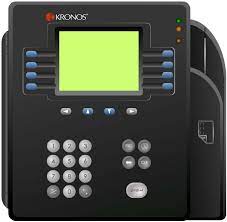 |
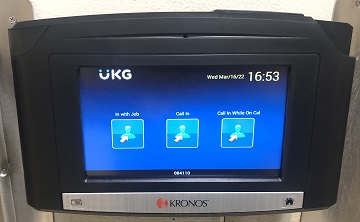 |
| Kronos Badge Reader | Updated Kronos Reader (March 2022) |
Fire and Security
A Detex watchclock
system was installed around the 1960s on the River Campus and Medical
Center. Pinkerton security personnel would make rounds and use the
unique key in each station to record the time on a recording clock to
verify that the location was visited at a certain time. A few of
these stations can still be found.
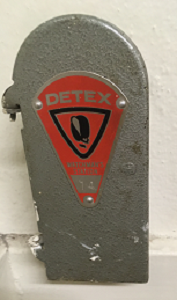 |
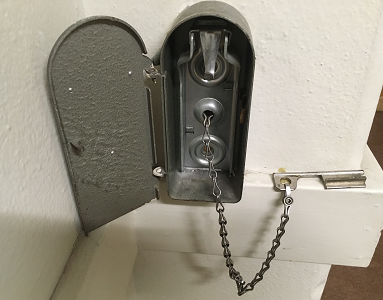 |
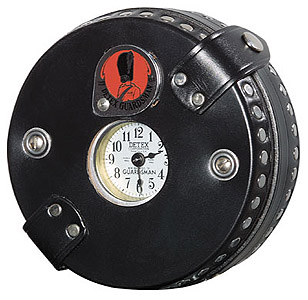 |
| Detex Box | Detex Key | Detex Watchclock |
A centralized fire alarm system was installed in 1977 that automatically signaled security and the Rochester Fire Department. A dial 13 emergency number was also established in 1977. Blue light emergency telephones were installed starting in 1984 and over 200 have been installed. Emergency telephones have also been installed in nearly 200 elevators.
Card readers were first installed at the Eastman School of Music around 1978. They were installed in the Founders Court dorms in 1983. The hospital parking garage opened in 1995 and was the first parking facility to use ID cards for swipe access. The parking access system was upgraded to AVI tags in 2008.
UR Smart ID cards were introduced to the University community in spring 2020 as an upgrade to the traditional magnetic strip cards for touchless access devices.
The first security cameras were installed at the Eastman School of Music by 1978 and around 1998 on the River Campus and Medical Center to monitor parking lots. The initial cameras were hard-wired to the security dispatch office but later camera operate over the campus network. Recordings were first done with video cassettes, but migrated to computer files. These video recordings were very valuable in convicting Chris Porco, our very own ax murderer. More than 650 security cameras are currently installed.
Locks
When the Medical Center first opened in 1925 there were very few locks
installed as the cost was seen as excessive compared to the potential
losses. Today there are lots of locks at the University, as shown
below:
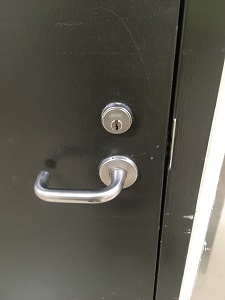 |
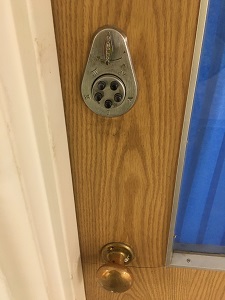 |
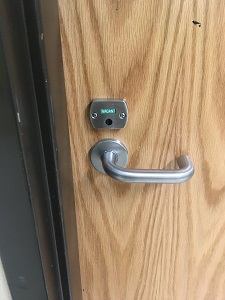 |
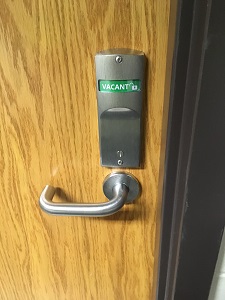 |
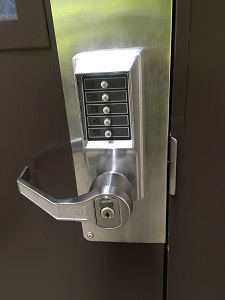 |
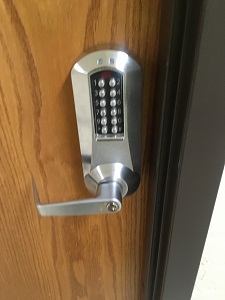 |
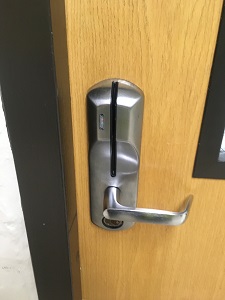 |
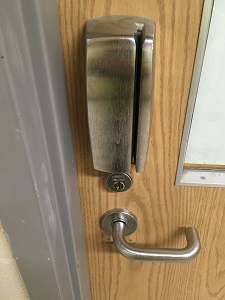 |
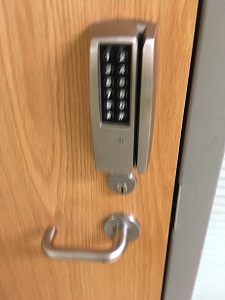 |
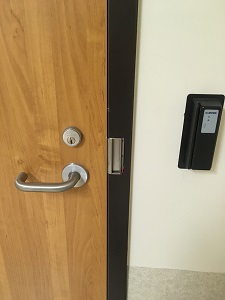 |
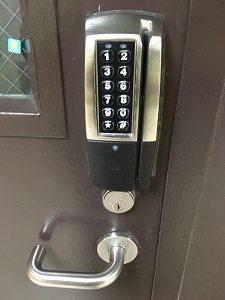 |
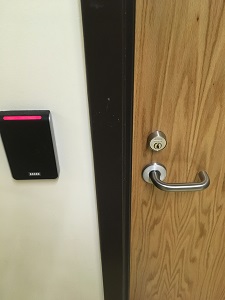 |
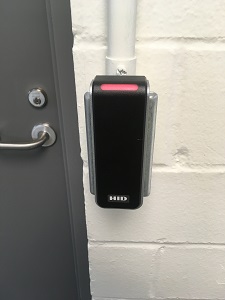 |
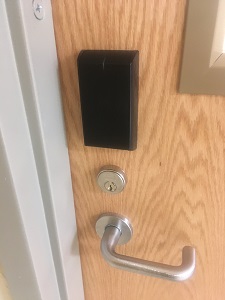 |
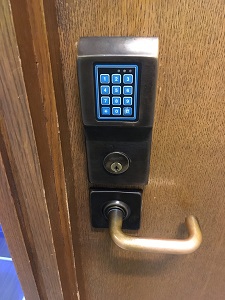 |
References
1882 Democrat
and Chronicle, June 25, 1882, Page 1.
A non-electric incandescent lamp suitable for magic lantern purposes in
schools where the oxy-hydrogen or electric light is not available, and for
a variety of other uses, has been designed by Dr. Regnard. An ordinary
Bunsen burner has a cage-like top of platinum wire, and instead of gas a
mixture of air and petroleum vapor is admitted and lighted, with the
effect of producing an illumination like that of electric incandescent
lamps, If all that is said about the device turns out to be true, the new
Regnard lamp will find a place in many laboratories, hospitals, and
workshops.
1886 The magic lantern manual Second Edition), by W.I. Chadwick
1889 "Hovey's
Photo Stock House," Democrat and Chronicle, March 3, 1889,
Page 6.
We have for sale a first-class Oxy-Hydrogen Optical lanterns with complete
set ot slides suitable for church and hall entertainments. Any person in
want of such an apparatus will do well to examine this, It can be sold at
much less than cost price.
1910 Bell
telephone directory, March 1, 1910
Page 228: University of Rochester, University av Chase 836
University of Rochester Gymnasium Chase 1364
1912 Bell
Telephone Directory for Rochester,
September 20, 1912
Page 238: University of Rochester, University av
Chase 836-J
University of Rochester Gymnasium
Chase
1364
1921 "Gas
Station for Official Cars Now Being Installed in Rear of Anderson Hall,"
The Campus, January 21, 1921, Page 1.
It is neither a grave, nor a trap to catch the campus squirrels that is
being dug behind Anderson Hall, but a position for a gasoline station.
A 550-gal. tank will be sunk in this 1 hole and a pump erected. This will
be for the use of the official machines, such as belong to President
Rhees, Secretary Ball, Superintendent Rohr, and "Dandelion", the college
lawn mower. It has not been decided as yet where the students and faculty
will be allowed to use this station, but if such a decision is reached,
the gasoline will be sold at cost. If everything goes well, the tank will
be finished in the near future.
1929 Rochester Telephone
Directory (*internal exchanges) .
*University of Rochester, Ofc, 44
Prince
Monroe 1237
Alumnae Sec, University
ave.
Monroe 7724
Eastman School of Music, 26
Gibbs
Stone 2212
Extension Division, 42
Prince
Monroe 1810
Faculty Club, 46
Prince
Monroe 6958
Heating Plant, College
ave.
Monroe 4859
*Library, University
ave.
Monroe 6959
Mens Dormitory, 47
Prince
Monroe 1237
*School of Medicine and Dentistry Crittenden
blvdMonroe 2000
Vocational Counsellor for Women,
Prince
Monroe 91
*Womens Dormitory, 430 University
ave
Monroe 1428
1930 Annual Reports
of the President and Treasurer, June 1930
Pages 29-30: Report of Sub-Committee on Visual Instruction
The Committee on Visual Instruction has made a survey of the existing
facilities and materials of the college which are available for visual
instruction and of the plans of the various departments to increase such
facilities and materials in the near future. In the case of departments
not now using these methods an attempt has been made to learn their
desires and intentions along these lines. A summary of that survey is
attached to this report.
This survey is admittedly incomplete, since only 16 departments reported.
Nevertheless it shows that the college now owns a very considerable amount
of material for the application of visual methods. For example: 22
projection lanterns, including 4 motion picture projectors, are now owned
by the college. There are over 11,000 lantern slides. representing 20
different subjects, 620 charts covering about 10 subjects, more than 4,000
feet of film, and over 13,000 maps (mostly geological). It was also found
that a number of departments are planning to increase their equipment and
that two departments are asking for appropriations for the first time.
1939 "Aerial
Fee Starts Controversy," The Campus, September 29, 1939,
Page 1. | Part
2 |
Fee to support installation of common aerial system. Cooking not
allowed in dorm rooms.
1939 "Petition
Fails to Change Rule on Aerial Fee," The Campus, October 13,
1939, Page 2.
Electric phonographs will be permitted in the dormitories, but will be
subject to the same fee as radios.
1939 "UR
Heads Reject Students' Protest Against Radio Fee," Democrat and
Chronicle, October 20, 1939, Page 23.
For the privilege of having radios and electric phonographs in their
dormitory rooms, University of Rochester students will pay $2.50 each
term, beginning with the second semester, it was announced yesterday.
1940 "Carnegie
Gift Gives Todd $1500 Musical Record Library," The Campus,
May 24, 1940, Page 1.
Grant is for 950 records and record player.
1940 "Student
Broadcasting Unit Planned for Men's College," The Campus,
May 24, 1940, Page 1. | Part
2 |
Local stations will co-operate in new project.
1945 Proceedings
Volume of the Geological Society of America for 1944, May 1945
Pages 185-222: Memorial to Herman Leroy Fairchild, by George Halcott
Chadwick. [Fairchild was geology professor at the UR from
1888-1920.]
Pages 192-193: The art of photography, then comparatively young, and
the art of lantern projection, still newer, appealed to young Fairchild
with all their educational possibilities and with an ardor that never
cooled. At his retirement from teaching in 1920, at the age of 70, he was
still using the lantern, that he himself had early built, and delighting
his classes with the fine pictures he had taken in many countries. Said
the Rochester Democrat & Chronicle at his passing:
Students will remember him fondly for his lantern slide lectures, always
willingly given if the students pleaded unpreparedness when they came to
class. He was the first professor at the University to use visual
instruction in his classes. He took his own photographs and made his own
slides, gathering a library of illustrations numbering more than 3,000.
His brilliance as a lecturer was once said to be equalled by only a few
teachers in the world.
When Professor Fairchild showed his slides he always talked directly from
the lantern as he inserted them. For a pointer he used a hatpin directly
against the plate shown. Many of his students adopted the same practice.
Doctor Hoffmeister writes that some of these old slides are still in use
at the University.
1947 Rochester
Past and Present: An animated scrap book for the edification of
future local historians, by William Wilkinson, June 1947
Page 62: List of University Telephone numbers.
1948 "Radiomen
Air Opener Tomorrow," The Campus, February 9, 1948, Page 1.
Using the University electric power system to beam the sound, station
engineers plan to reach by radio any campus resident who may tune his
radio to 650 kilocycles.
Centered in the control room and studios of the station in Burton
Dormitory on the River Campus. A line connects the River Campus
control room with the transmitter on the Women's College campus and
another line is maintained to the main telephone telephone exchange for
sending and receiving out-of-town programs.
1953 "Improved
Dormitory System Sparks River Campus Scene," by Artie Bernhang, Campus
Times, September 25, 1953, Page 1. | part
2 |
A new telephone system is in the process of being installed. It will work
from central switchboard in East dormitory. All incoming phone calls will
be received there, and then by means of the two-way speaker system
installed in the dorms, the party will be called to a convenient house
phone, one on each floor. Out going calls will be made by means of pay
phones in the dorms.
1954 Proceedings
of the December 8-10, 1954, eastern joint computer conference: Design
and application of small digital computers (December 1954)
Pages 50–54: Application of the Burroughs E101 Computer, by Alex Orden
1954 Burroughs E101
1956 "U. of R. Adding Computers in New Electronic Center," Democrat and Chronicle, January 27, 1956, Page 17.
1956 "UR Plans Computing Center to Aid Research, Teaching," Campus Times, February 10, 1956, Page 2
1956 "Heads
New UR Computing Center Dr. Thomas Keenan, Roch Graduate," Campus
Times, February 17, 1956, Page 5.
The first computer, a Burroughs E 101 of which only a few have been
produced, is expected to arrive this week. Next summer the center
will receive an IBM 650, a large-scale digital computer for its laboratory
in Taylor Hall.
1956 "University
Computing Center," Rochester Review 17(4):6 (March 1956)
As a result of a five-year study of computer techniques and equipment and
programs at other institutions, the University has established a
University Computing Center, to be equipped with the latest machines in
the new and fast-expanding field of large-scale digital electronic
computing and data processing.
The Center will provide an important service to the University's own
research and teaching programs and to industry. It will be located in
Taylor Hall, and its facilities will include a new Burroughs E 101
machine, of which only a few have been produced so far and which was
installed in February, and an IBM 650 electronic computer, to be received
this summer.
1957 "Taylor
Hall Whiz Will Do the Work if YOU Will Vote," Campus Times,
December 20, 1957, Page 1.
Present counting procedures for preferential elections requires
approximately 200 man-hours for the tabulation of ballots for the 9
candidates at large and 100 man-hours for the 9 class representatives, a
total of 300 man-hours.
The new, method will require only nine man-hours; six hours will be needed
to convert ballots to punched cards and three to process the votes through
the computer.
1957 A
Second Survey of Domestic Electronic Digital Computing Systems,
by Martin H. Weik, June 1957
Pages 48-49: Burroughs E101
University of Rochester acceptance test 1 April 1956
Pages 138-149: IBM 650 RAMAC Tapes Magnetic Drum Data Processing Machine
Applications
University of Rochester Computing Center
Physical research, statistics, educational tool.
Personnel requirements
University of Rochester Computing Center, One 8-hour shift requires 4
operators, including a Burroughs E101 System. Usually operated on
"open shop" basis. Most programming and operating is done by the
user who is not attached to the Computing Center
Reliability and Operating Experience
University of Rochester Computing Center
Operating ratio 0.95, period 10 July 1956 to 1 November 1956, accepted 10
July 1956.
Future Plans
A symbolic three address assembly-interpretive floating point system is in
process of development for basic 650.
IBM 650 RAMAC requires 35.5 KVA, weighs 14,000 lbs. and requires 8 tons of
refrigeration. IBM 650 Tapes requires 42 KVA, weighs 15,000 lbs. and
requires 9 Tons of refrigeration.
1957 "Behind the Giant Brains," by Frank Leary, Radio and Television News 57:37-41 (January 1957)
1958 (March) Burroughs E-102, 1 Electro - instruments converter/graph plotter used for educational and research purposes.
1960 "WRUR
to Build New Tower, Use New Broadcast Band," Campus Times,
May 20, 1960, Page 2.
The broadcasting frequency of WRUR will be changed from 650 to 1090
kilocycles, in another move designed to bring the reception of WRUR on a
par with other city stations.
1961 IBM 650 carted away
after the previous system was installed.
1961 "UR
Computing Center Plans to Install Larger Machine," Campus Times,
April 7, 1961, Page 5.
The new computer system - an IBM 7070 - will replace the IBM 650 currently
in use.
1961 "New 7070 Arrives on
River Campus," University Record 1(4):3 (September 1961)
By October a new IBM 7070 will be at work in the UR Computing Center as
the first such installation in the Rochester area and one of four or five
such installations in universities throughout the country.
The 7070 will replace a 650 computer and make possible a greater growth in
the range and scope of problems that are posed. Some problems are not
“realistic” to try to answer on a 650 because of the complicated, lengthy
procedures which would be necessary. The new machine differs from the 650
in memory capacity, speed, flexibility, sophistication, and in
calculations per dollar.
1961 "Computer
Center To Receive Grant," Campus Times, October 20, Page 3.
| Part 2 |
$200,000 from National Science Foundation to install new IBM 7070.
1961 "Secretary's Friend
- or Enemy?" University Record, November 1965, Page 6.
New IBM magnetic tape Selectric
1961 "University Unveils IBM 7070 At Computing Unit Opening," Campus Times, November 7, 1961, Page 1. | Part 2 |
1961 "The
University of Rochester...One University in a Changing World: A
Ten-Year Report," Rochester Review 24(1):1-36
(October-November 1961)
Essential to such an intensified research program was a computing center.
Such a center was established in January, 1955, beginning with a
desk-sized Burroughs E-101. The basic IBM 650 was added within six months.
By 1959, a larger 650 system had been installed and the Center was
offering regular courses in computer programming. With a painstakingly
developed library of standard programs and routines, the Computing Center
staff has assisted many University divisions and departments with research
projects and problems, and, in subjects relating to or using computers,
has been able to provide assistance and demonstrations for classes both at
the University of Rochester and at other institutions.
Computer-oriented projects have increased steadily. By 1961 - with the
installation of an IBM 7070 computer -faculty members needing a major
computer facility in their research were able to work with one of the most
completely equipped centers to be found at any eastern university.
1962 (June) IBM 1620 installed (desk-type machine) in Hopeman.
1962 "Keeping Tabs on the
University," University Record 2(11):4-5 (December, 1962)
A battery of various IBM machines fills the area occupied by Tabulating
Services. They may look mysterious and somewhat forbidding to the
uninitiated, but actually their functions are both businesslike and useful
to departments throughout the University.
1963 "New 7074 Computer
Installed at UR," University Record 3(7):1 (July-August 1963)
The University currently is installing a new IBM 7074 computer system to
replace the IBM 7070 computer installed less than two years ago. The new
system commenced operation July 1.
According to Vincent Swoyer, acting director of the University Computing
Center, the IBM 7074 system consists of new high-speed components plus
components converted from the existing 7070 model. The new system will be
considerably faster than its predecessors — its computing speeds are two
to ten times greater than those of the older model.
Valued at about $1.5, million, the new installation is used in conjunction
with IBM 1401 and 1620 computers got scientific calculations.
1963 "7074, 1401 Are Well Versed Aids; Used by a Variety of Departments," Campus Times, October 18, 1963, Page 2
1964 "Alarms Improved in WRH, Towers," Campus Times, October 2, 1964, Page 2.
1965 "Planners
Okay Zoning for Motel Addition," Democrat and Chronicle,
August 26, 1965, Page 5C.
A proposal to rezone a strip of land along Elmwood Avenue for expansion of
the Towne House Motor Inn, 1325 Mt. Hope Ave., was approved yesterday by
the City Planning Commission. Owned by the University of Rochester and
leased by the motel corporation under a 50½-year agreement, the additional
land would be used for construction of a swimming pool and two-story,
33-unit addition to the motel. The basement of the addition will house a
university data-processing computer unit. Attorney Frank Goodwin,
appearing for the U. of R., said the 240-foot strip of land, which extends
to 500 feet in depth, would revert to the University's ownership when the
lease expires. A unique feature of the addition's construction would be a
wall within the building which would allow tearing down a portion of the
addition on the property lines.
1965 "Secretary’s
Friend-Or Enemy?," University Record. 5(10):6 (November 1965)
The new Magnetic Tape "Selectric” typewriter, operated by Mrs. Judy
Martyn, is the latest mechanical marvel in the Administration Building. It
automatically types any number of copies of form letters, charts, or
anything else a secretary with a regular typewriter can turn out. The
operator types the original on the “ Selectric,” which simultaneously
records it on tape. The machine can type at the rate of 186 words per
minute.
1965 "Computing
Center Serves University; Facilities Open to Qualified Students," Campus
Times, December 3, 1965, Page 2. | Part
2 |
This center, located in Taylor hall and Hopeman engineering building, is
primarily used for scientific research and routine problem solving by the
faculty and students. The personnel at the computing center must have an
extensive scientific and technical background.
The administration has its own data processing center for grading,
registration, payroll, and other business of this nature.
The center consists of two systems, coordinated to form a complete
computer service. The primary system, located in Taylor 40, includes the
IBM 7074, with the IBM 1401 acting as an auxiliary device to interpret the
output of the IBM 7074. Therefore, the IBM 1401 is not used as a computer
but mainly to eliminate the input and output bottleneck and thus free the
larger computer to handle a greater work load.
In addition to the IBM 1401's high speed printer and card punch-reader,
there is a Calcomp plotter available for plotting curves and diagrams of
output from IBM 7074.
In room 133 of Hopeman another system is located — the IBM 1620. This was
installed primarily for student use. The center has peripheral card
preparation equipment in addition to its computer.
The IBM 7074 is operated only by the center's staff. The 1620 however, can
be operated by anyone who has previously been checked out on it. The users
reserve time on a sign-up sheet in room 133. However, if they prefer, they
can submit programs to be run by a staff operator.
Of the several programming systems and languages available, the use of
Fortran, an algebraic system, is advised since it is relatively easy to
learn and use. However, there are special systems for the IBM 7074 for
those with a more formal programming background.
Most of the equipment is leased, although about half of the 7074 system is
owned by the university. Total value of all the computers is about
$1,800,000.
In late December of 1955, the computing center, consisting of a Burroughs
E-101, was established in Taylor hall. In the spring of 1956 an IBM was
installed and continually modified until it was replaced by an IBM 7070
which was later converted to the present IBM 7074.
Students could operate the IBM 650, but the complexity of the IBM 7070 and
7074 prevented students from getting valuable first hand experience.
Therefore, in August 1962, the IBM 1620 was installed for student use.
1965 Democrat
and Chronicle, December 4, 1965, Page 1C.
The University of Rochester Computing Center is moving its offices and
much of its equipment from the River Campus to the ground floor of the new
addition to the Towne House Motor Inn next spring, according to Thomas A.
Keenan, director. The university plans to rent the space for five years.
1965 "Computing
Area to Move Offices," Campus Times, December 7, 1965, Page
4.
Will move to the ground floor of a new addition to the nearby Towne House
Motor Inn next spring.
The University's IBM 7074 and IBM 1401 computers will be moved to the new
location, along with offices for center's staff members. The IBM
1620 computer, used for instruction of undergraduates, will be transferred
from the Hopeman engineering building to space freed by the center's move
from its present location in Taylor hall on the river campus.
1966 "WRUR-FM Makes Debut," Rochester Review 28(4):23 (Summer 1966)
1966 "Computing
Head Named at UR," Democrat and Chronicle, July 7, 1966,
Page 3C.
The UR Computing Center, with offices in the Towne House expansion in
Elmwood Avenue, was among the first such centers in the country
1966 "New Phone System Will Make UR Calling Easier, Quicker," University Record 6(8):1 (September 1966)
1967 "Centrex
System To Simplify University Phone Operations," Campus Times,
September 26, 1967, Page 1. | part
2 | part
3 |
A phone in every dormitory room is now a possibility with the university's
new Centrex telephone system. This system will eventually encompass all
exchanges on campus.
Making outside calls from the university will be "nowhere near the problem
we have now," according to Douglas Brummel, head of the UR Communications
center. The center, located at 1510 Mt. Hope avenue, controls all
telephone communications.
The present system is somewhat complicated. Certain divisions in the
university community have their own phone numbers and extensions, but each
of these numbers is just one of many in a central Rochester exchange.
DIVISIONS
Divisions include the River Campus administration (473-3000), River Campus
residence halls (244-8200), Strong Memorial hospital (473-4400), Eastman
School of Music (325-4370), the Memorial art gallery (473-0450), the
Nuclear Structure laboratory (244-5990), and several others. There are 13
different numbers for university connected areas.
To make an outside call from a university phone to a non-university phone
the caller must dial a 1-digit access code (9) to get an outside line and
a normal dial tone. All local calls may be completed in this way.
Toll calls (long distance, person to person) or collect calls must first
go through a university operator so the proper department may be charged.
She then gives the caller an outside line to complete the call.
To make an intra-university call from a university phone the caller picks
up the receiver and gets the university dial tone. This is a different
pitch than the normal dial tone. When calling within a particular system
(i.e., to another phone that has the same exchange number or first three
numbers such as 473) the caller merely dials the extension number to reach
his party. If, however, he wants to call another division he must first
dial an access code.
For example, when dialing from a River Campus phone, to Strong Memorial
hospital, the caller must dial the access number 8, wait for the Strong
dial tone (which one does not always get if the connecting lines are
completely tied up) and then dial his extension. For certain of the
divisions (namely Eastman) this is not the case. There is no transfering
of calls and anyone wanting an extension there must go through the Eastman
operator, after first dialing the number as he would any outside call.
Calls coming into the university and any of the different divisions from
the outside go through a different procedure. The caller must first know
which division he wants.
After picking one of the 13 numbers he dials it and gets one of the
thirteen operators.
He then gives her the extension number he wants and she will complete the
call. If he is unsure of the extension the operator must look it up and
then complete the call. It is often simpler to call person to person if
one anticipates trouble in locating the desired party. This is especially
true for people calling long distance to the residence halls (244-8200)
since the person called must be paged by intercom to come to the phone.
The information procedure with the present system is also somewhat
haphazard. Various numbers for the different divisions are listed in the
metropolitan directory, but very few specific extensions are. An outside
caller may have to redial to a different division to reach his objective.
The university operators can, to a certain extent, transfer an outside
call between divisions, but they too must use the time consuming procedure
for internal calls outlined above.
OPERATOR PROBLEMS
Due to the number of divisions, it is not possible for each number to have
operators on duty 24 hours a day. Consequently, some numbers cannot be
reached at certain times. Examples include 473-3000 on Sundays, and
244-8200 (residence halls) during the night.
Emergency calls are also a problem. Each division has to have either
its own emergency number or an access code to a different division's
number. In many cases it might be easier to contact the operator
immediately since she is more familiar with the necessary connections that
have to be made (such as getting an outside line to get the Rochester Fire
department).
The Centrex system is expected to simplify the procedure. Every university
connected phone will come under a new exchange, 275, which will be used
solely by UR. Each telephone line will have its own number, 275,
plus four digits. If a particular extension presently has more than one
telephone connected to it, then each phone will assume the same Centrex
number.
The main feature is that a caller from the outside can dial directly any
telephone in the system without dealing with an operator.
DIRECT DIALING
To make an outside call, one will still have to dial 9 to get an outside
line, but there will be more lines available and there should be no wait.
"The biggest feature" according to Brummel, however, "is direct inward
dialing."
The last four numbers act as an extension number, and a caller merely
picks up a phone, gets the university dial tone, and can immediately
connect with any other telephone in the system. Access numbers and an
operator are eliminated. Emergency calls can be made by dialing one
four digit number from any phone in the system.
The ability to transfer calls from one extension to another will be
available, under the new system. If a call has to be transferred to
another extension during a conversation, one would dial the digit 1 and
the person on the other end would be automatically placed on hold. One
could get a dial tone and then dial the new extension.
After telling the party on that extension that he has a transfer call
waiting one would hang up and the hold caller would automatically be
transferred to the new extension.
A minimum of five operators is needed at any one time to handle the
system. Therefore, 24-hour service will be possible for all divisions. The
operators will serve mainly for information purposes. Persons unsure
of the extension they want would dial 275-2121 for information.
The operator could then transfer the call or give the extension number and
ask the caller to redial directly. This method, according to Brummel,
would encourage people to keep track of particular numbers and eliminate
much of the work for the operators.
More numbers will be listed in the metropolitan directory, rather than
only division numbers, as is now the case. An all new university directory
will be published which will have every telephone in the system listed.
Brummel estimates that "about 1% of university telephones are unlisted"
and these will continue to remain that way with Centrex.
The Centrex system will eventually be able to handle 8,000 individual
lines, or about 10,000 telephones. The equipment in the communications
center is manufactured by Stromberg-Carlson, and all of the installation
and mechanical work is being done by Rochester Telephone corporation.
RTC, which is the largest independent phone company, "couldn't possibly
convert everything at the same time," and it will be "the summer of 1968
before any big changes will be made," says Brummel. On December 3, 1967,
however, all administrative phones at the university will be converted.
According to Brummel, "we've been doing this for well over two years,' and
"negotiations with RTC in terms of costs and services," are still going
on. He is unable to say, therefore, just when or in what fashion the
dormitories will be connected to the system.
On December 3, 244-8200 will become a Centrex number but the intercom
system will still be used. As is now the case, one will not be able
to use residence phones for outside calls. Brummel hopes to eliminate this
but he also feels "the only way you can really do it and have an efficient
system...is to share phones among small groups of students. The Towers
set-up is ideal.*
Billing is one problem as yet unsolved. If every room on the men's quad
had a phone shared by roommates, security would have to be incresed to
prevent people from making toll calls on other people's phones. One
solution is to restrict the phones so that they would be operative only
for local calls.
Pay phones would be used for toll calls. Another solution would be to get
locks for each telephone.
These matters remain to be negotiated but Brummel feels there will
"definitely" be an improved system for the dorms. He is presently talking
with other universities that have made the change.
"At 12 midnight...the conversion will take place.' This is a low traffic
time. The Centrex wires will be attached and the old wires disconnected.
The only work done to the telephone instrument will be completed prior to
the conversion and consists of putting the new Centrex number of the dial
with a temporary sticker bearing the present number over it.
Another big advantage to the system is billing of phone calls. According
to Public Service commission rules a residential phone may have unlimited
local dialing but a business phone such as the university's must pay for
each call made.
All local calls are paid for by the university and not charged to
individual users. This will continue to be the case. Toll calls, however,
will be billed by RTC through the Communications center to each line in
the system.
A more accurate check on calls made is then possible, and payment can be
made directly instead of the present billing by the university. The
cost of the conversion to the university Brummel estimates to be roughly
"about $40,000."
Although Brummel feels "we don't have all the answers" and "we don't know
what we can do" as regards dorm plans, he is "negotiating many programs
for the benefit of students." Ultimately he hopes the Centrex telephone
system will result in improved service for the entire UR community
1967 "Start of new
telephone system near," University Record 7(10):1 (November 1967)
Centrex, after two years of planning, is scheduled to begin operation on
Dec. 3. The new automated system will link UR telephones directly to
millions of telephones in this country and Canada.
Centrex will provide direct communication between all University campuses;
it will make it possible for the more than 100 million telephone users in
the United States and Canada who are part of the Direct Distance Dialing
system to reach any UR switchboard without the aid of a University
operator; it will make it possible for you to place a call to any one of
those same 100 million telephones, just as you would from your phone at
home. Additional special services are also possible under the Centrex
system.
The simplest way of describing Centrex is to say that the University has
been given a Rochester Telephone Company exchange of its own. As of Dec.
3, all University telephones will have been assigned a new seven-digit
number; "275" followed by a four-digit extension.
Complete information on Centrex procedures is presented on pages four and
five of this issue. It is suggested that they be saved for later
reference.
1967 "Centrex
Corrections," University Record 7(11):7 (December 1967)
The Centrex system uniting UR campuses under one telephone exchange went
into effect on Ded. 3.
1968 "Centrex To Ease Phone Overload Completion Scheduled for Summer," Campus Times, February 9, 1968, Page 9.
1968 "Speedier
Computer for Data Processing," Currents, July 11, 1968
Data Processing Dept. in Admin. Bldg. to receive an IBM 360 model 50 to
replace an IBM 1401.
1968 "UR's
New IBM Computer in Operation," Currents, September 12,
1968.
The IBM 360 Model 65 computer which was recently installed in the UR
Computing Center located on the ground level of the Towne House, 727
Elmwood Avenue, become operational yesterday, Sept. 11, at 4 pm.
This computer replaces the IBM 360 Model 50 which will be transferred to
the Data Processing Center in the Administration Building on River Campus.
1968 "A
Computer Systems Approach Towards the Recognition and Analysis of
Content," by Howard P. Iker and Norman L. Harway, Computer
Studies in the Humanities and Verbal Behavior 1(3):134-154 (October
1968)
Implementation of the Words System.
Computing Facility.
WORDS has been developed at the University of Rochester Computing Center.
Until recently, all large scale work in this facility has been run on an
IBM 7074 computer. The 7074, a second generation, medium-speed machine,
has characteristics including extremely powerful input/output (I/0)
hardware and logic, and highly flexible scatter read/write commands. It is
a fixed word length machine (five characters or ten digits with sign per
machine word) with decimal arithmetic and hardware supported floating
point operations. The configuration at the University of Rochester
operates with a JOK core and is supported by eight 729-IV tape drives and
a 1301 disk file. Final output from the system must be to tape with all
printing and punching done offline on an IBM 1401 configuration.
This configuration runs under control of the Computing Center's resident
monitor which operates the system on a batched queue basis. As such, all
daytime runs operate under closed-shop conditions with all operations
handled by a computing-center machine operator.
Reprogramming of WORDS
The University of Rochester has recently acquired an IBM 360 model 50
computer and will, within another year, update that machine to a model 65.
WORDS will be reprogrammed to run on the 360. Programming on the IBM 7074
had, of necessity, to be in assembler language because no higher level
language existed capable of doing the job. PL/I has met that need and
reprogramming for WORDS will be in that language. Because the 360 is a
very popular machine, we shall, for the first time, have the ability and
opportunity to make the WORDS System available to others outside the
University proper.
1970 "The
History of the University of Rochester Libraries--120 Years," University
of Rochester Library Bulletin 25(3):106 (Spring 1970)
Most trying to the librarians may have been the operation of the
University switchboard in tiny quarters, adjacent to the reserve reading
room on the first floor of the library. Before the war, University
authorities thought nothing of asking girls on the library staff to take
turns operating the switchboard to relieve the regular operators on noon
hours. During the war, however, they asked for more and more overtime work
on the switchboard, and Russell's patience was strained. His solution,
until the day this practice was abandoned, was to have the library girls
operate the switchboard as part of their regular hours instead of on an
overtime basis.
1970 "Radio and Television in the Life of Rochester," by Blake McKelvey, Rochester History 32(2):1-28 (April 1970)
1970 Inventory
of Computers in U.S. Higher Education 1966-1967, by National
Science Foundation, August 1, 1970
Page 11-18: University of Rochester Computing Center
IBM 1130 1967
IBM 1401 1961
IBM 7074 1963
IBM 360/50 1967
1970 "UR Data Center Expand, Falls Behind in Workload," Campus Times, October 30, 1970, Page 3.
1972 Inventory
of Computers in U.S. Higher Education 1969-1970, by National
Science Foundation, March 1, 1973
Page 11-24: University of Rochester Computing Center
IBM 360/65 1968
IBM 360/20 1969
IBM 1130 1966
UNI 9200 1969
1973 The Xerox Alto was introduced on March 1, 1973. Xerox donated four of these machines to the University in 1974, which were named John, Paul, George and Ringo.
1974 ARPANET Logical Map, August 1974, shows University of Rochester Eclipse and DCU-50 ported from Rome Air Development Center (from 2015 reference below), compare with 1978 ARPANET Resource Handbook
1975 "UR
Increases Energy Cutbacks," Campus Times, January 27, 1975,
Page 1. | Part
2 |
Temperature and utility control will be centralized in the Central Utility
Plant. This consolidation will also allow the fire alarm system to
be centralized.
1976 "Campus Master Clock Causes Time Problems," Campus Times, March 29, 1976, Page 1.
1976 "New
Program Now in Use in Dining Halls," Campus Times, September
20, 1976, Page 1. | Part 2 |
Under BEV, UR id cards contain a magnetic tape encoded with a number that
validates a student's right to participate in the food service
program. When a student enters the dining hall, his card is inserted
into a card reader. A central
1977 Apple II released, June 10, 1977
1977 "New
Security phone system established," Campus Times, September
5, 1977, Page 5.
In case of emergency on campus dial 13 anywhere within the Centrex system.
In event of a fire in a residence hall, both Security and the Rochester
Fire Department will automatically be notified b a new computerized system
which links fire alarms to Security.
1977 "UR's
Fire Safety Program dependent upon cooperation," Campus Times,
October 14, 1977, Page 2.
A large sum of money was expended during the last several years to update
the fire protection systems in the buildings. All fire alarms
origination from any of the buildings wil be automatically transmitted to
the Rochester Fire Bureau and fire companies will respond.
1978 "Security
increased at Eastman," Campus Times, January 25, 1978, Page
1. | Part
2 |
The two entrances to the Eastman School of Music are also under close
watch. The Swan Street entrance can be opened only by those having
an Eastman ID encoded as a key card. The card is unlocked by
inserting the card into a lot, and limits access to faculty and students
who use the parking lot on Swan Street.
A number of surveillance cameras are getting used both inside and outside
the school which continuously monitor various areas.
1978 "High
speed computing system delivers 'astronomical' results," Campus
Times, September 29, 1978, Page 3.
CDC 6600 at Laboratory for Laser Energetics
1978 ARPANET
Resource Handbook, October 1978
Page 831: University of Rochester is sharing a port with RADC (Rome
Air Development Center)
1978 "UR
Computing Center published a more complete newsletter," Campus
Times, October 17, 1978, Page 3.
The installation last July of a new IBM 3032 computer (replacing the old
IBM 360 model 65) has created a need for an additional means of
distributing Computing Center information.
1979 On January 26, 1979 the University of Rochester received a $1,000 award from the National Association of College and University Business Officers for money saved by using the Wide Area Telephone System (WATS). WATS uses least cost routing for all long distance calls and allows businesses to purchase blocks of long distance time in advance. WATS was implemented under the Centrex system.
1979 "Programs
moved to IBM 3032 increasing efficiency, speed," Campus Times,
October 2, 1979, Page 3. | Part
2 |
The transfer of all computer work for the Administration, Registrar,
Academic, and Business offices to the new machine should be completed
sometime between mid-October and mid-November.
The 3032 was installed at the Towne House in June of 1978. The $2.1
million dollar cost is to be partially offset by a savings of roughly
$5,000 per month in maintenance costs when the IBM 360 in the basement of
the Administration building is shut down.
These systems, the new computer, and the approximately 150 terminals
throughout the campus are all steps towards "hacking down the barriers
that stand between people and their computing resources."
1980 "Wyatt seeks library computerization," Campus Times, September 16, 1980, Page 1 | Part 2 |
1981 Xerox introduced the 8010 Star information system on April 27, 1981.
1981 The Xerox 820 was introduced in June 1981 for $2,995 with two 51⁄4-inch single-density disk drives with 81K of capacity per diskette, or $3,795 with two 8-inch drives with 241K capacity.
1981 IBM Personal Computer released, August 12, 1981
1981 "UR to Create Unified Computing System," Campus Times, November 4, 1981, Page 1 | Part 2 |
1981 "Currents,"
Campus Times, November 4, 1981, Page 5
Currents has been in existence since October 5, 1973.
1982 "Letters
- Altos Gamesmen," Byte 7(2):28 (February 1982)
While Thomas Wadlow's "The Xerox Alto Computer" (see September 1981 BYTE,
page 58) was most interesting, I'm sorry he didn't mention that Xerox also
donated four Altos to the Computer Science Department at the University of
Rochester in 1974. In fact, two of the games pictured in the article were
written by graduate students there.
Trek is the work of Eugene Ball, who also wrote Death Star (in which you
pilot your Alto down a trench in the Death Star and fire a torpedo at its
only vulnerable spot to save the Federation). Pinball was written by Clint
Parker. You can jiggle the "table" by holding down the space bar. Overly
energetic application of the space bar results in a "tilt." Clint's
version of Space Invaders remains one of the most popular Alto games. It
keeps track of the top ten scores on the net. No still photograph can
convey the fine graphic details of these programs.
Incidentally, the four original Altos at University of Rochester are named
John, Paul, George, and Ringo (my own suggestion was Groucho, Harpo,
Chico, and Zeppo).
Michel Denber
Xerox
1982 "Computer
Facilities Expanded," Campus Times, September 17, 1982, Page
1
The new systems, housed in a revised Taylor Hall, include a Decsystem 2060
and a VAX11-780.
1982-1983 First serious initiative towards word-processing on campus. Up to this point, electric typewriters were used. Systems from Wang, DEC, IBM, and Xerox were tested. The University bought 300 to 400 Xerox 860's (large cases) and 820's (desktop) with 8" floppy drives were purchased. These machines were dedicated to word-processing.
1983 "Personal Computer Making Itself at Home in Dorm Rooms," Campus Times, January 18, 1983, Page 3. | Part 2 |
1983 "Electronic
Lock and Nightwatch Improve Security in Towers," Campus Times,
March 23, 1983, Page 1.
Security in Towers Residence Halls has been improved with a new electronic
lock system. The Towers now have the tightest security on
campus. The new lock system requires students to run their speciall
encoded I.D. cards through a reader which unlocks the door for eight
seconds.
A similar lock system was successfully used in the Eastman Dorms.
1983 "Computer
Interest Floor Seeking Students," Campus Times, March 28,
1983, Page 2.
Letter from Matt Curtiss, CIF Chairman, March 27, 1983.
1983 "Digital
Directions: Hardly a Terminal Venture," Rochester Review
45(3):8-13 (Spring 1983)
How is Rochester arming its students for the computer revolution? Through
a well-stocked arsenal of courses, laboratories, and research projects,
backed by an impressive buildup in materiel. Here is the computer illiterati's
guide to some of the action.
So far, Rochester's completed shopping list for additions to Computing
Center resources available to all students and faculty includes two big
new time-sharing machines – a VAX 11/780 and a DEC-2060; sixty new
terminals; expansion of its collection of micros with the addition of
fifteen APPLE IIs and twenty IBM personal computers; and the newly
installed data switch that permits any keyboard around the University to
talk to almost any computer it wants to.
The central portion of Taylor Hall, the Computing Center's River Campus
facility, houses the brand new DEC-2060 and the VAX 11/780 mega-mini.
There are also three terminal rooms linked to an IBM 3032 two blocks away
at the Towne House facility and to the DEC-10 mainframe at the Medical
Center.
1983 "Net
Aids Medical Center's Search for Grants," Computerworld
17(30):30 (July 25, 1983) | pdf |
The center selected a network based around a number of Xerox Corp. 8010
workstations which combine computing, writing and editing with the
creation of charts, graphs and mathematical equations. Betz said the
center will also add some Xerox 860 and 820 personal computers.
1983 - Computer Interest Floor started in GLC. Your timeline doesn't mention the creation of the undergraduate Computer Interest Floor (CIF) in 1984 to prototype the integration of computers into daily student living. CIF occupied the top floor in one of the two towers then called the Graduate Living Center (GLC). CIF originally had two Apple IIs, a couple of modems, a couple of phone lines, and an Applewriter provided by the Computing Center. The diversity during CIF's first year was interesting - many students had computers that student's today have never heard of, including Texas Instruments, Sinclairs and so forth. In addition, the students that lived on the floor were from a wide variety of backgrounds with many interests - not just your typical "computer geeks". For one, CIF had about a 50/50 split between men and women. In addition, some of the students had interesting hobbies - one woman rode her motorcycle around the 11th floor of GLC. Contributed by: Matt (Magic Matt) Curtiss '83-84
1983 "New phone system planned for UR," by Maria Thomas, Campus Times, September 26, 1983, Page 1. | part 2 |
1983 "Computer store opening soon in Fauver Stadium," Campus Times, September 28, 1983, Page 7.
1983 "Libraries
to get new computer system," Campus Times, October 17, 1983,
Page 1 | Part
2 |
The UR will purchase the system from GEAC of Toronto.
1983 "Computing centers to consolidate soon," Campus Times, November 30, 1983, Page 1 | Part 2 |
1983 "Direct-dial emergency phones to be installed," Campus Times, December 9, 1983, Page 5A.
1983 "The
University Computer Store," Campus Times, December 9, 1983,
Page 15A
Visit our temporary location, room 404, Baush & Lomb Building
1984 "Automated
Library," Rochester Review 46(2):31 (Winter 1983-84)
The customer enters.
He steps up to a computer terminal and, with a few deft strokes,
determines the location of the desired goods.
Information in hand, he speeds past shelf after shelf, knowing just where
to look.
Finally, goods stashed securely under the left arm, he strides with
confidence toward the computerized checkout.
It's time to start that term paper.
The scenario reads more like a trip to Rochester's largest supermarket
than a research visit to a University library, but finding a book will be
just that easy after a conversion process involving the library's nearly
two million volumes and eight million catalog entries.
With the system in place, says library director James F. Wyatt, patrons
will be able to search the library system's holdings from terminals
located in offices, labs, or the library itself. They will retrieve their
books from library shelves, and staff members will release them after
linking a bar code in the book with the one on the patron's ID card.
The whole system - on-line "card" catalog and electronic checkout - is
scheduled for completion in the spring of 1985, Wyatt says, but the first
online catalogs will start appearing in science libraries in the fall.
Before movers cart away the old catalogs, staff members must transfer
their contents to the library's own data base. Two years have passed since
librarians started that process, and about 100,000 records have been
transferred. By the fall, Wyatt expects to have four or five times that
number on line.
The library began the conversion using grants totaling about $370,000 from
the estate of Fanny Knapp Allen. (Mrs. Allen was the wife of Wheeler
D. Allen' 12, president of the former C. P. Ford Co., a local shoe
manufacturer.) The library is engaged in an appeal for additional funds to
complete the automation project.
The automation project, Wyatt says, was first proposed in 1980. This past
summer, project managers selected their computer system, one made by GEAC,
Inc. of Toronto.
"GEAC's software is tailored to our type of needs," Wyatt notes. The
system will allow speedier and more comprehensive searching of research
material, and often will point out material that would have been
overlooked in a manual search.
In addition, he says, the system will improve the University's access to
other research libraries across the state and beyond.
Once workers complete the catalog conversion, they will place a coded
circulation strip in each book in a process known as "linking." Linking,
library workers say, will effect the first complete holdings inventory in
at least fifty years, and will make future inventories far easier.
The complete automation project will be costly, Wyatt observes, but the
final price has yet to be determined. "We're not sure exactly how big that
data base is going to be-that's really the key to how much it's going to
cost."
Wyatt and his staff are exploring still further uses for the new system,
including automating acquisition of new material. For now, though, they
have their hands full.
"In 1980 we were way behind," Wyatt says. "We have moved up through the
pack and now are slightly ahead, particularly when compared to other
libraries our size."
By the time library assistant Margaret Feldman and her colleagues are
finished with the conversion process, a streamlined system of "on-line"
cataloging will replace the familiar ranks of card catalogs that record
the UR library collection of two million-plus volumes.
1984 Macintosh released, January 24, 1984
1984 "ID
card entry systems to be installed in all dorms," Campus Times,
February 13, 1984, Page 1. | Part
2 |
The key-card readers are presently in use in Anderson and Wilder Towers
and Burton and Crosby Hall.
1984 "Registration
faster with new system," Campus Times, March 23, 1984, Page
1. | Part
2 |
Course registration to be done on computers.
1984 "UR
receives grant for computer," Campus Times, November 7,
1984, Page 3.
The Butterfly computer will be housed temporarily in the Towne House
computer center.
1984 "Xerox
awards UR a computer system grant," Campus Times, November
19, 1984, Page 3.
Xerox will provide 12 Star workstations (very powerful personal computers)
and an Ethernet system.
1984 Vax 11750 - first
UNIX (BSD) box on campus, Vaxes moved to Towne house; Taylor housed UNIX
machines only
1985 First mini/micro computer purchased; (Commodore PET)
1985 "Centrex rate increase sought," Campus Times, February 21, 1985, Page 1.
1985 Apple Laserwriter released, March 1, 1985
1985 "University to
benefit from new NSF supercomputer facility," Currents, March 1,
1985, Page 1.
The National Science Foundation announced Monday (Feb. 25) that the
University is among 12 institutions to benefit from an anticipated $200
million, five-year program establishing four National Advanced Scientific
Computing Centers.
The University will share a supercomputer to be located at the John von
Neumann Center for Scientific Computing near Princeton, New Jersey. A
Control Data Corporation Cyber 205 initially will be used at the Center,
and should be operational by late 1985 or early 1986.
The Cyber will be upgraded within 18 months to the much larger ETA Systems
GF-10, a multiprocessor supercomputer being developed by ETA Systems, Inc.
When the GF-10 is fully operational, it will have approximately 40 to 50
times the computing power of the Cray-1, one of the most advanced
supercomputers now made.
The completed GF-10 will have a storage capacity of about 2.4 billion
bytes of information, with eight independent processors and backup storage
for another 10 trillion bytes of information. For comparison, a typical
personal computer has a storage capacity of about 256,000 (or 256K) bytes
of information.
A mainframe computer typically has capacity for up to 32 million bytes.
Each of the 12 participating institutions will be connected by
communication lines specially designed to handle the high speed data
transmissions generated by the supercomputer at the John von Neumann
Center.
1985 "Library
reference system to be computerized," Campus Times, March 4,
1985, Page 1
Beginning in mid-April UR libraries will install computer terminals to
replace the existing card catalog reference system.
The 120 terminals were purchased from the Toronto based GEAC corporation
for an estimated cost of $400,000. This figure includes the
"software", or programs that will run the computer.
The system will eventually be hooked up to the UR mainframe computer, so
that any personal computer connected to the mainframe will have access to
the system.
1985 "UR
prepares for new supercomputer," Campus Times, April 1,
1985, Page 7.
BBN Butterfly multiprocessor with 128 separate processors
1985 "Computer
access will be available in dorms," Campus Times, April 11,
1985, Page 6.
Recent developments in River Campus computing will offer new opportunities
for all users beginning next autumn.
Three rooms in River Campus residence halls will be equipped with eight
Apple Macintosh microcomputers and a printer.
Four Macintosh machines at each site will connect directly to the UR's
mainframe computers via a data switch and four will be equipped with
optional connections to the switch. In addition, four extra data
connectors will be available for students to hook their own microcomputers
to the switch.
The hookups in these rooms wil be eight times as fast as any modem a
student might have in his or her room.
Plans call for the computer rooms to be staffed part-time six days a week,
and available 24 hours each day. The cost for the project, which is the
first phase in equipping River Campus residence halls for computers, is
around $100,000.
Four or five Macintosh machines are to be installed at the Eastman School
of Music as well.
An online University Bulletin Board will provide information to the entire
University community.
Among the services planned for the bulletin board, which is based on a
similar system at Cornell University, are academic course listings, bus
schedules, campus movies and other social events, and Currents. Access to
the bulletin board will be though computer terminals connected to the data
switch.
Those involved with the project hope to place eight to twelve public
terminals around campus to allow aecess for those who don't usually use a
computer connected to the switch.
A program will be established to help faculty members develop computer
software for use in teaching.
The program would make available the services of staff consultants to
faculty members who want to develop their own "courseware." Assistance
would be granted by a faculty committee on a case-by-case basis.
1985 "Chester combs every
cranny searching for your books," Currents, June 14, 1985, Page 2.
Next time you’re passing through Rush Rhees Library, you should make a
point of meeting Chester.
I did last week, and can honestly say he was much easier to get to know
than I’d ever have expected.
Chester, for those of you who haven’t yet met him, is the on-line catalog
system now in use on a limited basis in the Rush Rhees, Edward G. Miner,
and physics libraries, and who will arrive soon at other University
libraries.
He’s the program and database connected to the video terminals you’ll see
near the reference desks in these libraries, and his memory contains
information bn most books and journals received by the River Campus
libraries and the Edward G. Miner library since 1974, as well as most
materials received by the Sibley Music Library since 1982.
How did Chester get his name, you wonder? “It’s a short form of
Rochester,” Chester’s project director Ray Metz explains. It’s a name that
went over big with other University library staffers because it reminded
them of Chester Dewey, one of the founders and first faculty members of
the University, for whom Dewey Hall is named, and also was reminiscent of
Chester Carlson, who invented the xerographic copying process and who’s
the namesake of the River Campus library.
Chester is replacing the card catalog. Instead of looking up materials by
opening one of those long, narrow drawers crammed with hundreds of cards,
you sit down in front of Chester’s screen, punch in a few commands on his
keyboard, and watch as he reveals the library’s holdings in your area of
interest. Push the “help” key, and Chester thoughtfully gives you
instructions on how to proceed with your search.
The day that I stopped by, I was doing a little research on Native
American writers, so I asked Chester to do an author search for N. Scott
Momaday’s stuff. (He won the Pulitzer Prize one year for his novel, House
Made of Dawn, so I figured the library would have it.)
Uh, oh. Chester found nothing. There must be a mistake, I thought, and
sure enough, there was. I had made a typo in the author’s name. Like other
computers, Chester is very literal-minded; you have to spell the author’s
name correctly, or he won’t give you what you’re looking for. Once I fixed
the error, however, Chester revealed that the libraries had several
Momaday books, including the prize-winning novel.
Chester’s menu of instructions showed that I could search by subject, too,
so being a weekend gardener, I indulged my curiosity about the libraries’
horticultural holdings. I told Chester to dig out books with “gardening”
in the title, and he unearthed a screen full of tempting tomes, with call
numbers and locations of the books.
One of Chester’s attractive features is that you have access to catalog
records for all library locations from a single terminal. So without
visiting the Carlson Library, I found out what gardening books were there.
One of these days, Metz says, Chester’s terminals may be equipped with
printers, so that you could have him print out the information contained
on a screen. But for now, you have to take notes, just as you do at the
card catalog.
Over the summer and the next academic year, a couple of terminals each
week will be installed at Rush Rhees and other University libraries, until
a total of 120 terminals for all of the libraries has been reached.
Eventually, Chester will replace the card catalog entirely, but he is not
yet fully equipped to take over that job. Though the most recent and most
heavily used materials are now recorded in Chester’s memory bank, some
older materials and some information about periodicals have yet to be
recorded.
“We want to have full confidence in this electronic catalog before we
discontinue the card catalog,” said James Wyatt, director of University
libraries. “So we will be maintaining both the card catalog and the
on-line catalog for a couple of years before we make the complete
conversion to an on-line catalog.”
Chester is brought to you in part through a $500,000 grant from the J. N.
Pew Charitable Trust of Philadelphia.
Perhaps by year’s end, he will contain not only catalog records, but
circulation records as well. You’ll be able to check out books by having
them scanned, along with your ID card. The library staff expects that
Chester will help them manage acquisitions and periodicals and hold
records for administrative bookkeeping, as well.
For the time being, however, his main function will be to perform searches
of the catalog.
If you haven’t yet made Chester’s acquaintance, be sure you do so on your
next trip to the library. I can personally recommend him as a
user-friendly tool that researchers will find more convenient than
stooping over for the drawer they need — which always seems to be the one
at the bottom — and more fun than rifling through four million dog-eared
index cards.*
1985 "Electronic card readers to tighten security in dorms," Campus Times, September 23, 1985, Page 1
1985 "New phones on the
way," Currents, October 25, 1985, Page 1, 3.
The University is purchasing a state-of-the-art telecommunications system
which will link all telephones and computers on campus in a single
communications network.
This telecommunications system, manufactured by the Rolm Corporation, a
subsidiary of IBM, is being installed over the next 15 months by Rotelcom,
a Rochester Telephone Corporation subsidiary and local distributor for
Rolm. The $19.6 million project is being supervised by Rochester Telephone
Corporation, which is acting as the University’s general contractor. Henry
J. Miller, director of telecommunications at the University, said, “the
combination of the technological sophistication of Rolm and IBM with the
local support of Rochester Telephone and Rotelcom will greatly benefit the
University.”
At the University’s request, several companies submitted proposals for a
telecommunications system designed specifically for the University.
Committees representing various segments of the University and Rochester
Telephone analyzed the proposals, visited sites where each manufacturer’s
equipment was installed, and attended technical briefing sessions at
manufacturers’ research and development facilities. These evaluation
committees selected the Rolm. system as the best and least costly for the
University, and because it will allow full integration of telephone and
data communications at will.
By simply adding a data communications module to a phone, that phone can
be used for simultaneous telephone and data transmission, with no
additional wiring.
With the new telecommunications network, any student who wanted to keep a
personal computer in his or her dorm room could do so, and have access to
mainframe computers for homework assignments or special projects,
explained Richard Mandelbaum, vice provost for computing.
Also, students or faculty with personal computers could have access to the
on-line library catalogue, and could therefore look up books from the
office or bedroom. A student could also call up the University’s
electronic bulletin board of information from his room.
Where both faculty members and students have personal computers, students
might complete term papers on the computer, send them to the faculty
member, and the instructor could read the paper, grade it, and return it
to the student without the exchange of any paper.
This system will provide more universal computer accessibility, making the
computer an even more powerful tool in support of the University’s
educational and research programs.
Particularly important is the ability to combine telephone and data
communications without installing a separate network.
This fall Rotelcom will begin installing cable for the new system. In
order not to disrupt telephone service, the new cabling, some of which
will be fiber optic cable, will be installed throughout the University
alongside present cable, and later, new telephones will be placed on every
desk next to the present ones. The present system will continue to operate
until the entire system of new phones, the switch, and cabling is put into
operation early in 1987, according to Alan L. Heyneman, associate vice
president for administration.
The following schedule lists some of the steps in the process of
implementing this new system at the University:
Target Dates
• Contract signed — October, 1985
• UR phone users surveyed — October, 1985-January' 1986
• Cable installed — October, 1985-January, 1986
• Switch installed — August, 1986
• Switch tested — September-October, 1986
• Training begun — Two months prior to cutover
• New system cutover — early 1987
The first step in this process will be a University- wide survey of
telephone and data needs. During the next three months, representatives
from the University and from Rotelcom will contact someone in each
department to provide information about types of service, available
features, and rates which departments can use to choose their Rolm
telephones.
“These easy-to-use telephones are among the best available in the industry
today,” said Miller. “Even the basic model has buttons that activate
various features specified by the individual, which will make the
telephone a more useful tool, saving time and increasing productivity.
Although these phones are easier to use than many other new phones, they
are far more complex and capable of many more uses than are our present
phones.
For that reason most people will require some training to be able to use
them effectively. Before the system is put into operation, every
University employee will have an opportunity to be trained to use his or
her new phone to its full capacity.”
With this new system, faculty, staff, and students will have more and
better telephones and earlier access to lower cost long-distance telephone
service, as well as having increased access to computer networks on campus
and world-wide. The Rolm system offers numerous telephone features —
flexibility, a simple transition for telephone users, and potential for
future enhancements. It also has safeguards to assure against total
network failure. It consists of more than a dozen independent segments,
each supporting up to 1,000 connections, which will be distributed in key
locations throughout the University: If any segment should fail, all the
remaining ones will continue to function as a network.
In addition, its capacity for handling 13,000 telephones, 5,000 of which
can be equipped with data communications modules, and 1,800 data-only
connections, is expected to serve the entire University, ineluding
on-campus undergraduate residence halls, into the 21st century. John H.
Cline, president of Rochester Telephone’s Telecommunications Group, said,
“Rotelcom is uniquely experienced and qualified to install à project of
this size and complexity. Together with Rochester Telephone, we offer a
blend of technical expertise, product and local presence which will
provide the University one of the nation’s finest telecommunications
systems.”
1985 "UR to install new telephone systems," Campus Times, November 8, 1985, Page 9.
1985 Microsoft Windows released, November 20, 1985
1985 "Card
readers no long accept Visa." Currents, December 6, 1985,
Page 1
All UR Residence Hall card readers were connected to the new computer
system as of Tuesday, November 26 and can no longer be activated with a
magnetic strip of any credit card.
1986 (Summer) first vax cluster
1986 "The
Other Side of the Window," Rochester Review 49(2):5-9
(Winter 1986-87)
Radio station WRUR broadcasts twenty-four hours a day, 365 days year - on
a relatively modest signal of 1,000 watts.
1986 "Here's where you
learn about the care and feeding of your personal computer," Currents,
February 28, 1986, Page 2.
New Microcomputer Information Center in Taylor Hall
1987 "Info
available at Micro Info Center," Campus Times, February 26,
1987, Page 5
Taylor Hall
1987 "'Chester' grows," Currents,
February 2, 1987, Page 7.
No more card catalog for the Physics, Optics, and Astronomy (POA) Library
in Bausch & Lomb Hall. On Jan. 2, the library became the first site to
depend on “Chester,” the University libraries’ computerized online
catalog.
Chester now offers bibliographic records for all books and journals
cataloged for the POA Library. It also represents 97 percent of the books
and journals housed in the River Campus science and engineering
collections, all River Campus and Miner Medical Library monographs
cataloged from 1974 to date, and Sibley Music Library books from 1979 to
date. Chester also contains information on many periodicals and book
series, as well as many works cataloged before 1974.
You’re encouraged to use Chester when you begin a search for books in the
University’s library system. Right now, searches can be made by title,
author, Library of Congress subject heading, and the International
Standard Book (or Serial) Number.
The POA Library transition will be evaluated over the next six months.
Successful results will help other. University libraries in turn make the
switch to Chester.
1987 "Computing
Facilities Growing," Campus Times, February 12, 1987, Page
7. | Part
2 |
All floors will be equipped with Chester, the library's electronic
reference center.
1987 "New
research network," Campus Times, February 12, 1987, Page 7
NYSERNet. The UR was linked to the network three weeks ago. At
first, NYSERNet will carry 56,000 bits of information per second but will
later be upgraded to 1.5 million bits per second.
1987 "New phones arriving soon to River Campus," Campus Times, February 28, 1987, Page 7.
1987 "New telephone system will create problems for its users," letter from Jason A. Korosec '90, Campus Times, April 30, 1987, Page 3A.
1987 IBM PS/2 personal computer introduced
1987 "Phonaphobia: helpful hints to cure it," Campus Times, September 14, 1987, Page 7
The ROLM (a subsidiary of
IBM) phone system allowed the first wide-spread access to the mainframes
for UR students in 1985. The mainframes that were made accessible included
Curio, CMS, Dbvax, Vera, etc.
The system was designed so that every room (defined as "four walls and a
bed" by Henry Miller, then director of Telecommunications) would have an
exclusive extension, which replaced the old Centrex system of two rooms or
an entire suite per extension.
This phone system upgrade necessitated that UR take over two exchanges (a
third has since been added): 274, and the existing 275. This gave the
University a capacity of 12,000 lines at the time.
The total cost of the phone system was $19.6 million (individual phones
were $100), including the built-in v.28 bis 9600 baud modem, and ability
to have simultaneous voice and data transmission.
The project was originally scheduled for completion by Spring of 1987, but
due to some difficulties, was re-scheduled to be done by that fall.
1987 Fourth
Annual UCLA Survey of Business School Computer Usage,
September 1987
Appendix 2-8: U of Rochester (Simon)
HP 3000 (1982)
IBM 4361 (1985)
Appendix 308: U of Rochester (Simon)
45 Apple Macintosh
10 HP Vectra
25 IBM PC/XT
23 IBM PC/AT
1988 "Computers
now open 24 hrs.," Campus Times, January 25, 1988, Page 1
MIC Center moves from Taylor to Reserve. Computing and Reserve
Library.
1988 "New
items on ROLM," Campus Times, February 18, 1988, Page 4
A new computer bulletin board has been installed on the VAX/VMS mainframe
and can be accessed by anyone who has an account on VAX/VMS. Just
connect to DB3 and then type NOTES.
Student accounts are also available on CMS and TUT (a UNIX
environment). Student accounts can be used to send electronic main
to friends at other schools (as well as to friends at U of R, as long as
they have an account).
1988 "CT
available on CURIO," Campus Times, April 18, 1988, Page 6
Campus Times may now be found on the CURIO system, the UR's
computer info system. CURIO, located at terminals across campus, may
also be accessed from off-campus, thus making CT available to
local residents and alumni as well as students - anyone with a terminal
that can connect to the UR's ROLM data network can access CURIO.
1988 "The
Computer Fair," Campus Times, October 20, 1988, Page 15.
Taylor Hall User Services will demonstrate how to use the RolmPhone
datalinks to gain access to CURIO, VAXNotes and Electronic Mail.
1988 "Computer
virus infects UR's UNIX system," Campus Times, November 17,
1988, Page 1 | Part
2 |
1988 "NYSERNet
Boosts Network Data Transfers To 1.5 Megabit/s," Computers in
Physics 2:104 (November-December 1988)
The New York State Education Research Network (NYSERNet) accelerated data
rates to 1.5 megabits per second this past summer, and is now ready to
support new large-scale supercomputing applications with the higher
bandwidths. The 1.5 megabit speed marks a 24-fold increase over NYSERNet's
former data rate, according to a report from the network's management.
NYSERNet is a regional network in the State of New York that ties into the
National Science Foundation's NSFNET. There are 23 sites on NYSERNet,
including Brookhaven National Laboratory, Upton, Cornell University,
Ithaca, and the University of Rochester.
1988 "The DECsystem-20 at Columbia University (1977-1988)," by Frank da Cruz and Christine Giancone
1989 Alliant (UNIX box)
1989 "Beep,"
Rochester Review 51(3):24-27 (Spring 1989)
"PhoneMail" comes to campus. Students can make dates, break dates, discuss
assignments, exchange gossip-and virtually anything else without ever
speaking directly to anyone. And they have put it to uses most of us would
never have dreamed of.
1989 "Not
All Talk," Rochester Review 51(3):27 (Spring 1989)
PhoneMail is just one of the many high-tech capabilities of the
University's ROLM phone system.
The system includes some 11,500 telephones, 3,900 of which transmit
computer data as well as "voice" and 1,800 of which transmit data only
(the rest are your everyday voice only). These phones answer to the
growing needs of some 6,400 students (4,600 undergraduate and 2,000
graduate), 1,000 faculty, and 7,300 staff- and those are just the
full-timers in each category.
The bottom line is a phone system as sophisticated as any in existence,
anywhere. Each standard phone comes with a 36-page "Quick Reference Guide"
(along with a "Quick Reference Guide Supplement"), explaining such
features as the "Camp-On" button (so you can "camp" on someone's busy line
and place your call when he or she disconnects) and the "Park" button (so
you can transfer a call to a busy extension and hold it there until the
line is free). And then there's the electronic "memory" for often-dialed
numbers, the ability to hold conference calls with up to eight parties,
and the "Pick-Up" button that lets you answer someone else's phone.
There are those who claim it takes a Ph.D. to figure it all out. But,
ultimately, the system does make life easier and more efficient - for a
lot of people. For instance, a professor can simultaneously talk on the
phone and transmit data over the same instrument. A student can submit a
term paper simply by dialing the extension of a professor's personal
computer, after which the professor can read and grade the paper and send
it back to the student's PC - all without touching a single sheet of
paper.
1990 Summary
Report IBM Management of Information Systems (MoIS) 1985-1990 Grant
Program, September 1990
Page 8: Although all of the schools had direct access to
mini/mainframe systems (10 schools acquired IBM 4300 series mainframes as
part of their grant and the other three already had mainframe access),
these systems played a minimal role in the instructional programs.
1991 "Rush
Rhees reserve move to circulation desk," Campus Times,
September 12, 1991, Page 3
The Computing and Reserve Library (CARL) has been officially transformed
into The Computing Library and Resource Center (CLARC). The reserve
functions of the old CARL are now located at the circulation desk.
1992 "Queue,"
Campus Times, January 30, 1992, Page 16
If you already use electronic mail and want to dial in from home, the
modem number for the University is 442-6210, 8 data and 1 stop bit, at
300, 1200 or 2400 baud.
1992 "The
Backbone," by Chip Nimick, Campus Times, March 26, 1992,
Page 4.
Network map; how to access the Chester card catalog using Telnet
1992 "Queue,"
Campus Times, September 17, 1992, Page 12
Be sure to get your electronic mail account
1992 "E-mail has undergraduates' glued to their screens," Campus Times, November 5, 1992, Page 4.
1993 Windows for Workgroups 3.11 released August 11, 1993
1993 "E-mail: today's future," Campus Times, November 18, 1993, Page 11 | Part 2 |
1994 "PhoneMail unplugged," Campus Times, September 29, 1994, Page 12.
1994 "Navigating
the Net," Campus Times, October 13, 1994, Pages 1A-8A
UR pays approximately $35,000 per year to the New York State Education
Research Network (NYSERNet) for access to the Internet.
Telecommunications is switching communication technologies from the 10Mb
Ethernet to a 100 Mb FDDI (Fiber Distributed Data Interface) network.
1994 "Gopher
territory expands while World Wide Web waits," Campus Times,
October 13, 1994, Pages 4A-5A.
CURio, the library's on-line card catalog can be accessed using
gopher. The University's experimental project with the Registrar's
office now offers class registration options in CURio that will enable
sudents to search classes b time and department. A list of closed
classes is also available.
1994 "Students
post projects on World Wide Web," Campus Times, December 8,
1994, Page 2.
These projects are still available on the Wayback Machine.
1994 "Visit us on 'The Information Superhighway'," Rochester Review 57(2):53 (Winter 1994-95)
1995
"UR adopts a home page on World Wide Web," Campus Times,
March 30, 1995, Page 2.
www.rochester.edu
1995 "Contest seeks name for UR computer network," Campus Times, April 6, 1995, page 2.
1995 Windows 95 released, August 11, 1995
1995 "Cable TV may soon be available," Campus Times, October 12, 1995, Page 4.
1995 "Net gains: A map of Internet use: past, present and future," Campus Times, October 26, 1995, Page 11.
1996 "Network access upgrade planned," by David Russo, Campus Times, February 22, 1996, Page 1. | Part 2 |
1996 "Network access for all," by David Russo, Campus Times, February 29, 1996, Page 8.
1996 "Rochester,
N.Y.: Land of the free market," Network World 13(20):1, 64
(May 13, 1996) | Part
2 |
It all started in January of last year when the state of New York agreed
to let the former Rochester Telephone Co. sell long-distance, cable and
cellular services in exchange for opening the local loop to competitors.
The University of Rochester has bought some T-1s and fax and Centrex
service from Time Warner over its SONET fiber at significant savings.
1996 "ResNet ready for activation," Campus Times, September 19, 1996, Page 3. | Part 2 |
1996 "Takeout made easy: access code no longer required for local calls," Campus Times, September 19, 1996, Page 5.
1996 "University offers home internet access," Currents, October 28, 1996
1996 "Making Connections," Campus Times, November 7, 1996, Page 11. | Part 2 |
1996 New ID cards issued
1997 "UR
considers new telephone system," by Lauren Baker, Campus Times,
March 23, 1997, Page 5.
To replace the ROLM system
1997 "CIF
introduces Internet service," Campus Times, April 10, 1997,
Page 5
The Computer Interest Floor has introduced a service allowing students in
non-ResNet equipped dorms to access the World Wide Web using graphical
browsers like Netscape Navigator and Microsoft Internet Explorer.
The new service, called Point-to-Point Protocol (PPP), was introduced on
March 17. PPP use the modem already built into a student's ROLMphone
to access the internet.
PPP service also allows students to use a range of Internet software such
as e-mail, news and chat programs at the 19,200 bits per second speed the
ROLMphone data ports offer. While this is significantly slower than
speeds offered by the ResNet system, it lets users view graphics - a
feature not available from Uhura.
1997 "Important
Information for the Fall," Currents, July 21, 1997
All rooms in the River Campus residence hall system and at the Eastman
Student Living Center are equipped with ROLMphones. In addition to
providing voice service, these telephones are equipped with a voice
messaging service and can be individually equipped to provide data
communications to both on campus and off campus terminals and hosts. The
University is in Phase II of the residential networking (ResNet) project.
Upon completion of ResNet, all River Campus residence halls, fraternities
and Eastman School residences will be wired for high speed computer
network access. This service allows students to use their computers in
their residence rooms to access the Internet worldwide. Students also have
access to on-campus information services like electronic mail, course
descriptions and schedules, lecture notes, grades, and the library's
state-of-the-art Voyager system. Students will need to equip their
computers with Ethernet 10Base T Network Interface Cards and line cords to
connect to this service. The University's Computer Sales department will
be stocking line cords, the 3COM EtherLink III 3C509B card for PCs, and
Dayna and Focus Ethernet adapters for Macintoshes. University Computer
Sales is located in Fauver Stadium.
The ROLMphone data feature will continue to be available on all ROLMphones
on request. This feature allows students to connect their personal
computers through an RS 232 C connector on the back of the ROLMphone and
gain access to other such computers, to the University's computer systems,
and to computer networks outside the University. Users will be able to
conduct voice and data calls simultaneously without interference.
Communications protocols for the various University mainframe computing
facilities and access guides for computing utilities will be published by
each of these service centers. Students who bring a PC to campus wanting
to make data connections should make sure their PCs are equipped to use an
RS 232 C interface. The data interface will be configured for 9600 bps
with no parity. (Students may modify these parameters according to their
needs.) A variety of interface cables can be purchased from University
Computer Sales.
Students who live off campus may connect to the University backbone
network for text-based connectivity by using a modem and dialing 256-7000.
For complete details, obtain a Modem Pool and ROLM/ELAN Bridge User Guide
by calling (716) 274-4357 and leaving your name and address. All River
Campus and Eastman School of Music student telephones are equipped with
PhoneMail, a voice messaging system that allows callers to leave messages.
Each PhoneMail box can store up to five messages. Additional message
capacity is available at an additional cost to the requesting student, and
may be obtained by completing the appropriate section in the student
telephone contract available in the Residential Life and residence halls
offices. Instructions on the operation of the PhoneMail feature will be
placed in rooms before students arrive on campus. Complete information and
instructions on all aspects of the ROLM system will also be available in
the front of the new student directory. Conventional telephone answering
machines will not work on the University's ROLM telephone system.
Special equipment and services are available for students who are hearing
impaired. For information about amplification, strobe light indicators,
and the use of TDD equipment, call the University Telecommunications
Division at (716) 274-4357.
University Directory Assistance is available weekdays (except University
holidays) from 7 a.m. to 7 p.m. Calls placed to the University operator at
all other times will be answered by an automated attendant that will
provide information only on reaching critical departments and services.
Students who wish to take advantage of the University's low cost long
distance service need to obtain a UTD Student Services issued telephone
authorization code. This code is valid from any University Rolmphone. Once
issued, this authorization code will be valid for the duration of the
student's stay at the University. The charges for calls placed using the
authorization code will be billed directly to the student via the term
bill from the Bursar. A telephone statement, itemizing those charges, will
be mailed to the student's CPU box each month. Any student also may make
private arrangements with another long distance carrier. There will be no
University charge for access to these alternate carriers. However, the
service provided by the University may prove to be the easiest to use, and
competitive with other carriers' rates.
Telephone service contracts for the freshman class were mailed in early
summer. During the last week of August, University authorization codes
will be delivered to the campus mailbox (CPU) of those freshman students
who have returned their signed contract to Telecommunications, and who are
registered for fall semester classes.
During the school year, telephone service contracts for mail in
registration will be available in the Residential Life and residence halls
offices. Students must be registered for classes before an authorization
code is assigned. Once registration status has been confirmed,
authorization codes will be delivered to the requesting student's campus
mail box within three days of receipt of their signed contract in the
Telecommunications Office. Eastman students may obtain student contracts
at the Eastman Living Center reception desk.
Network access accounts are offered at no additional charge to all
undergraduate students of the College. These accounts allow you to send
messages to friends and faculty at the University, friends at other
schools, and parents. Your accounts will also give you access to the
Internet and thousands of electronic discussion groups. Faculty members
incorporate the use of these accounts in their courses. Free classes in
how to use your network access account will be offered in September. The
schedule for these classes will be published during Focus on Freshmen
Week. Network access accounts are available to be picked up during
orientation or by stop ping by Taylor Hall on the River Campus.
The University Web, www.rochester. edu, provides information from a
variety of departments and student organizations. Students can access
course descriptions, class or course schedules, and phone directories for
students, faculty, and staff. Access to library catalogues, databases and
other information sources from around the world is also available.
1997 "As
ResNet expands, complaints increase," Campus Times,
September 25, 1997, Page 1 | Part
2 |
Towers, Hill Court and the Fraternity Quad completed. The
Residential Quad and the Susan B. Anthony Residence Hall were set up last
year.
1998 "UTD
plans new campus telephone system for '99," by Meghan Brown, Campus
Times, March 26, 1998, Page 3. | part
2 |
UR's current ROLMphone system is the subject of frequent breakdowns and is
not Year 2000 compliant.
1998 "UTD plans new phone system for '99," Campus Times, March 26, 1998, Page 3 | Part 2 |
1998 "Computing
with Tubes: The Savage Art," by Eric Barbour, Vacuum Tube Valley
Issue 9:18-20 (Spring 1998)
3. The First PCs Were Not Made in 1975
Page 19: Burroughs E101 and E102
One of the first desk-sized computers, the El0l was wildly popular
with defense contractors and military agencies, as well as banks and other
kinds of companies. More than 80 had been sold in the first 4 years after
the 1953 introduction. It used "pulse-coded decimal," meaning it was nor
capable of static operation--pulse length encoded each digit. A word was
12 digits wide plus a sign bit, and 220 words were scored on its
magnetic drum. Adding cook 50 milliseconds due co the time-division scheme
of its logic, and due to the slowness of the drum memory.
It and the similar El02 had a plug-board panel, removable co allow
exchange. Parts of program flow could be set up on a panel, so the program
would refer to panel settings. This was thought to make the programs
shorter and simpler. The keyboard and primer were a Burroughs "Sensimatic"
console, modified from its normal business-accounting uses. Programs were
read from a paper tape operating at 2 characters per second. The El0l
consumed 3000 watts and weighed 1800 pounds. It should be easy to see why
the El0l was quickly eclipsed by faster machines with more memory
capacity.
1998 "Taylor
computers to be down briefly," Currents, April 3, 1998
The following systems and services will be unavailable:
uhura.cc.rochester.edu
The Academic Cluster (troi.cc.rochester.edu, et al.)
the DBVAX Cluster
UCC Microsoft Mail Server
University Web pages (and any departmental web pages
that are housed on guinan)
USENET News (news.cc.rochester.edu)
The Macintosh Archive on the Taylor Appleshare server
DNS name service provided by cc.rochester.edu
(128.151.224.6)
all terminals and workstations in Taylor Hall,
including the Technology Resource Center and Macintosh classrooms in rooms
41 and 31.
1998 "Rates set for new telephone system," Currents, September 28, 1998
1998 "Student Television Station to Start Broadcasting Soon," Campus Times, October 22, 1998, Page 1. | Part 2 |
1998 "Security cameras not spying on Hill Court," Campus Times, October 22, 1998, Page 1. | Part 2 | Editorial |
1998 "What's your e-mail?," Campus Times, October 22, 1998, Page 8.
1999 "UCC
changes name; plans CLARC rehab," Campus Times, January 28,
1999, Page 1 | Part
2 |
Academic Technology Services
1999 "Faster
Internet to aid research," Campus Times, January 28, 1999,
Page 2
Over the next two months, UR will be connecting to a faster Internet
server that will allow information to be transmitted at speeds about
85,000 times faster than the average computer modem.
The connection is being made to aid research in the departments of
astronomy and physics.
UR is participating in the link as a part of Internet 2, a project
involving 130 universities that are collaborating on building faster
computer networks for use in research.
The link is expected to be fully operational by next year; Currently, only
three other universities in New York state are using the new system - New
York University, Columbia University and Cornell University.
A grant of $350,000 from the National Science Foundation as well as a
matching contribution from UR, make the link possible.
The faster connection, however, will not affect students' ResNet
connections.
1999 "Employee
reporting process sees major changes," Currents, May 24,
1999
Among the more significant changes are those being made to how an
employee's work hours are reported. Departments will soon be using new
blue time sheets that replace the current green time sheets. The new time
sheets will include added features, such as providing more room to write
information and supplying accrual amounts for all employees.
In addition, beginning on Sunday, June 20, 4,000 hourly employees,
including 2,000 nurses, now will use badge readers with the new Kronos
system to document their work hours. Those employees who previously used
API badge readers will make the switch to the Kronos readers.
1999 UTD announces phone-system rollout plan, Currents, July 6, 1999
1999 "Phone
system upgrade brings new features," Currents, July 30, 1999
All rooms in the River Campus residence hall system and at the Eastman
Commons Student Living Center now are equipped with new digital
telephones, including voice mail.
1999 "Note
ATS server system downtime," Currents, December 6, 1999
To ensure data protection through the Y2K rollover, Academic Technology
Services will temporarily remove from service the central systems that
don't have auxiliary power supplies.
The following ATS computer systems will be shut down at noon on Friday,
December 31, and brought back into service at noon on Saturday, January 1:
E-mail: mail.rochester.edu (uhura)
Academic cluster: troi.cc.rochester.edu; riker.cc.rochester.edu;
laforge.cc.rochester.edu; picard.cc.rochester.edu; ro.cc.rochester.edu
Online courses: courses.ats.rochester.edu
Name service: galileo.cc.rochester.edu
News: news.cc.rochester.edu
University Web service: www.rochester.edu (guinan)
2000 "Music
industry aims to end MP3 trading," Campus Times, April 20,
2000, Page 6
Napster
2000 "Napster alive and well despite controversy," by Joanne Wu, Campus Times, September 21, 2000, Page 5.
2001 "'716'
changes to '585' on November 15," Currents, November 5,
2001.
As of November 15, the area code for the Greater Rochester region changes
from 716 to 585. From November 15, 2001, until August 16, 2002, both 716
and 585 will work for long-distance calls to Rochester numbers.
After August 16, 2002, a caller using 716 for a Rochester number will
receive a recorded message instructing the caller to use the new area
code. This recorded message will continue until spring of 2003.
2001 The
Dream Machine: J.C.R. Licklider and the Revolution That Made Computing
Personal, by M. Mitchell Waldrop
Licklider received his PhD in Psychoacoustics from UR in 1942 and was
involved in ARPANET and other early networks.
2002 "University launches 'URWireless'," Currents, August 19, 2002
2003 "Cell
Signaling," Campus Times, April 10, 2003, Page 13
Signal strengths across campus
2003 "ResNet limits student use of uploading bandwidth," Campus Times, Summer 2003, Page 8.
2004 "Online payroll system launched," by Yosuke Adyama, Campus Times, October 7, 2004, Page 4.
2005 "WebMail software updated," Campus Times, October 6, 2005, Page 1.
2006 "Verizon
expands network," Campus Times, March 30, 2006, Page 1
Installation of new telephone tower on Plymouth Avenue
2007 The University bought a building 300 Science Parkway to house a new Data Center.
2008 "New
Parking System Being Installed at Medical Center," Vital Signs,
8/6/08
A state-of-the-art electronic parking system is expected to go live in
Lots A, 4 and EDC the week of Aug. 18, and will be phased into Lots 1, 2,
3, MRB and the Garage by the end of September.
The high-tech system relies on Automatic Vehicle Identification (AVI)
technology, which works similar to an E-ZPass. A slim AVI tag – resembling
a thick credit card, and affixed to the inside windshield near the
rearview mirror – links to an individual’s parking account and transmits a
unique radio frequency identification that grants access to lots when the
car pulls within 25 feet of the new high-speed gates. In time, electronic
message boards added to lot entrances will display the number of available
spaces in realtime, and immediately re-direct drivers should their
assigned lot fill up (the AVI tags will temporarily grant access to an
assigned back-up lot).
Letters will be mailed to all permit holders two weeks before their lot is
switched to the new system. Parking representatives will staff tables in
each lot to hand out tags (the first is free; additional or replacement
tags will cost $20 each). Permit stickers must still be displayed.
2008 Classroom Technology updates 1999-2008
2008 The
Computers Nobody Wanted: My Years with Xerox, by Paul A.
Strassmann
Page 92-94: Xerox 860 Word Processor
As was the case that would be repeated many times over the next decade,
after the acquisition of Redactron the transplanted Rochester engineers
embarked immediately on the development of an improved version of that
device, which was then discontinued. Instead, Dallas now offered the Xerox
860, a high feature word processor that was then advertised and sold as a
premium product. It was an expensive system for $14,000, with
maintenance costs to match. The costs
of marketing this machine were also
high. After full accounting for
development, training materials and overhead it was not
profitable, especially after other firms, such as IBM’s text
editor and the Wang Laboratories word
processing systems entered the market with lower priced
equipment. The Xerox 860 was actually a minicomputer that was based
on the CP/M operating system. Soon every major office products firm
competed in this market segment (even Exxon ventures had an offering) and
the market share of Xerox word processors shrank rapidly. The Xerox 860
was a superbly engineered and over-featured product that
offered the preparation of documents
that could automatically contain line numbers, generate a
table of contents, format footnotes and type outlines. It had a spell
check function with 88,000 words in its dictionary. The full-text monitor
could display 70 lines of 102 characters. It stored working files on one
of the two 8” floppy disks. Each disk catalog could store up to 560
documents.
The objective of IPG was to make its divisions profitable. Instead
of pressing for further product
improvements and cost reduction, IPG jumped
to concentrate on producing an
extremely low-cost electronic typewriter that
would be based on the daisy
wheel mechanism acquired from a Diablo. When Tom Winter became
the CFO for the Information Product Group product development in the
document-processing segment shrank while funds were
getting diverted into the typewriter business. The
document processor business was quietly abandoned four years later while
pursuing other directions. There never was a product that Tom Winter could
not choke. Titsworth let the Xerox 860 die slowly as a new executive
emerged as the President of the Office Products Division in Dallas, Don
Massaro, formerly President of Shugart. Massaro had a different
agenda than the pursuit of a
small but stable document processing
business.
Xerox 820 Microcomputer
For its time the Xerox 820 eight bits microcomputer was a reasonably
competent machine that was an also run, without any distinct competitive
advantages. It was rushed into production by Massaro and positioned as the
initial Xerox entry into the distributed computing business. The Xerox 820
was driven by CP/M and was equipped with competent Shugart floppy disk
drives. The CRT itself was a 24-line, 80-character white-on-black
monochrome display that was quickly surpassed by competition. Its main
feature was the MicroPro WordStar as well as Microsoft BASIC-80 but little
else that would make it attractive though its price of $3,000 was
moderately under IBM’s offering. When software developers shifted their
attention to writing hundreds of applications for the IBM/Microsoft
offering the Xerox 820 became an irrecoverable failure. Whether an
upgrading of this microcomputer could have salvaged this product line is
debatable because Xerox management was now
spending time dithering about administrative costs and
how to sell computers to national accounts. Instead of upgrading the Xerox
820 some scarce funds were diverted to development of a battery powered
hand-held microcomputer with only a two-line LCD screen. Without much
funding and without a capable technology the Xerox 820 as well as the
two-line device would be abandoned.
2009 "End
land lines," Campus Times, March 5, 2009, Page 5
The University is currently evaluating room phone usage, and it should go
forward with a plan to remove these superfluous commodities.
2013 The University acquires a backup data center in Farmington
2014 Expanded Technology Services Improve Students’ Residential Experience, University IT, March 14, 2014
2014 "Burroughs E101 - a weird computer", May 4, 2014.
2014 "A
Dynamic Attitude," by Janice Bullard Pieterse, Rochester Review
76(6):30-45 (July-August 2014)
Page 44: COMPUTERAGE: The University established its first computer
center with a single desk-sized machine in 1955. The center was
upgraded a year later and again in 1961 to keep pace with changing
technology.
2015 "The
Production and Interpretation of ARPANET Maps," by Bradley Fidler
and Morgan Currie, IEEE Annals of the History of Computing
37(1):44-55 (January-March 2015)
Page 48: ARPANET logical map, March 1974, shows University of
Rochester Eclipse and DCU-50 ported from RADC
2016 "The
rise and fall of the Gopher protocol," by Tim Gihring, MinnPost,
August 11, 2016
Twenty-five years ago, a small band of programmers from the University of
Minnesota ruled the internet. And then they didn’t.
2018 “WRUR is on the air...” 70 years of college radio at Rochester.
2023 U
of R buys property in Canal Ponds, May 3, 2023
The University of Rochester has completed the purchase of the former IBM
facility in Canal Ponds Business Park and will use the property’s high-end
data center to support advanced computing and research activities.
The deed for 1630 Long Pond Rd. was filed with the Monroe County Clerk’s
office on Monday.
The building’s tier 3 data center made the property attractive to the
University of Rochester as it delves deeper into in machine learning and
AI. When fully commissioned in early 2025, the data center will support a
host of computing and research efforts, including within the Laboratory
for Laser Energetics and at the UR Medical Center.
Some material of this page was produced by my students in the 1990s, including Ezra Gold, Matthew Shambroom, and Mathew Felthousen. Their original pages are still viewable here and here.
© 2021 Morris A. Pierce